It's proving very hard to track down my old reviews that weren't put in the featured reviews section, and "extended preview" writings on Head-Fi. The longer I left doing this, the harder to find those p/reviews would have become. Part of this is my fault: I should have put something very clear in the title to identify them later, but I didn't. It looks like it might take a while to hunt down all my more substantial writings on Head-Fi. Don't hold your breath. Meanwhile, I'm sure there will be more actually new posts.
Friday, January 28, 2005
Tuesday, January 25, 2005
Testing, testing
I sometimes get asked: What do you test phones/sources/cables/etc with?
I have set 'virtual albums' which I use to select the stuff I actually want to keep. But in order for a review of something to be useful, you've got to cover a wide range of bases... there's not much point in reviewing based on just the music you like. The test tracks get chosen for a variety of reasons... specific tones or whole passages, the quality of production (or indeed, the lack of production quality), vocal tics, etc.
Here's a sample of the #1 track list I used to test the MDR-XD200, the latest phone to be listened to. It's fairly representative of the variety that I'd pick to test out a phone.
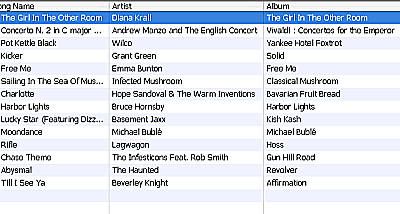
It's also important to test based on the intended primary use of the phone. For example there is no point sitting at home listening to and reviewing your Shure/Etymotic canalphones... some may use the phones in this manner, but the vast majority won't.
While I was writing my notes, because I was talking about it as an office/home phone and it is a very low-cost phone, I listened to the tracks from both their 256K MP3 rips on iTunes unamped from a PC in a quiet office environment, and also most of the tracks from the headphone jack of a mini system and one-box HT system at home. Of course I'll be listening to it from my more usual set-ups, but I'll always try and base the review on use within the sort of environments that the phone will be put in.
I have set 'virtual albums' which I use to select the stuff I actually want to keep. But in order for a review of something to be useful, you've got to cover a wide range of bases... there's not much point in reviewing based on just the music you like. The test tracks get chosen for a variety of reasons... specific tones or whole passages, the quality of production (or indeed, the lack of production quality), vocal tics, etc.
Here's a sample of the #1 track list I used to test the MDR-XD200, the latest phone to be listened to. It's fairly representative of the variety that I'd pick to test out a phone.

It's also important to test based on the intended primary use of the phone. For example there is no point sitting at home listening to and reviewing your Shure/Etymotic canalphones... some may use the phones in this manner, but the vast majority won't.
While I was writing my notes, because I was talking about it as an office/home phone and it is a very low-cost phone, I listened to the tracks from both their 256K MP3 rips on iTunes unamped from a PC in a quiet office environment, and also most of the tracks from the headphone jack of a mini system and one-box HT system at home. Of course I'll be listening to it from my more usual set-ups, but I'll always try and base the review on use within the sort of environments that the phone will be put in.
Monday, January 24, 2005
Sunday, January 23, 2005
Sony MDR-XD200 Review
The chances of you being able to buy a low-cost closed phone from Sony which sounds anywhere near acceptable has been, in my view, marginally less likely than the Apocalypse.
Sony isn't a company which I associate with good low-end closed headphones. The MDR-V500DJ (actually not so low-end in terms of what most people are willing to pay) is one of the few headphones that I have actually dumped in the bin. The very popular (in terms of sales to the general public) MDR-V300DJ is if anything even more crappy, with absolutely awful 'badly closed phone' acoustics. Just generally, low-end Sony headphones seem to be pretty dire. The newer-generation (open backed) MDR-G74SL was however a nice surprise, being an acceptable phone and better than I expected for a very low cost, mass-market portable phone.
Recently, a friend of mine asked me what he should buy for office use on a budget of £20 ($35~$40). I didn't really have a definite idea what to recommend, except for say "spend more", but one of the alternatives he presented to me was the brand new Sony MDR-XD200 (for £20). The new XD range has just come out in Japan, and I was quite surprised to see that they are available in the UK already. I nominated him for guinea pig role, and said he should buy the XD. He's not really what I would call a critical listener, so I was assuming that even if they were only marginally crappier than the MDR-G74SL, he'd probably be happy. So, we got together the next day and he turned out to be very pleased with the choice. I also had to have a listen out of my laptop, and...
"What was that?"
"What?"
"Did you just see four really underfed looking guys on horses go past?"
"What're you talking about?"
"Cloaked, one of them carrying a large farm implement?"
"Huh?"
"Um... Never mind."
These sounded good. REALLY good. Of course, my expectations were low but still... there was undeniably a hi-fi patina about these phones without all the bad things that usually accompany low-end Sony closed headphones. Three hours later, I got one for myself.
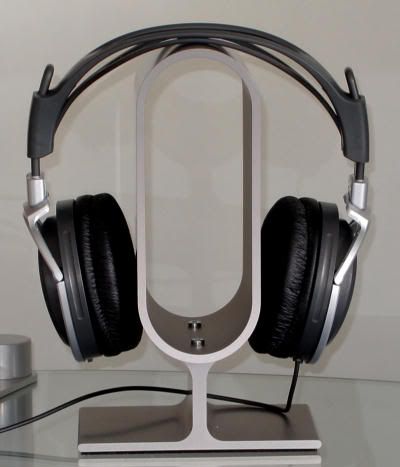
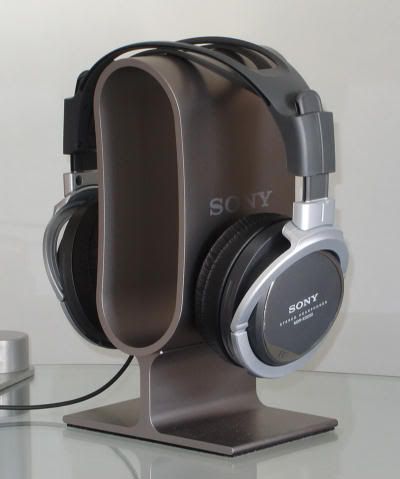
The cups look oval in most views of the XD series, but they are actually circular.
TECHNICAL
The closed-back, circumaural XD200 has 40mm drivers claimed to be 'long stroke'. Efficiency is a decent 102db/mw and the impedance is 70 ohms @ 1khz. The phone ships terminated with a 3.5mm jack, with a 6.5mm converter plug. The MDR-XD200 has angled drivers.
SOUND
It's actually got a very nice mild tone, which resolves more than sufficiently for a phone of this price yet doesn't display any traces of sibilance or nasty shrill highs. It's all quite a bit smoother than you expect for this budget. There is a tendency to gloss over some detail, but I can live with the tradeoff for this little money. Bass is very firmly planted with a good bloom without overextending into mush. Staging is less 2-D than some $200+ phones I've had. Although the staging is not large, environmental cues are certainly represented correctly. I can use words like 'instrument separation' without falling off my chair laughing. I have to say this is pretty disconcerting. I'm sitting here writing this post, listening directly out of my PC and I'm still looking out of the window, just in case the Seraphim start putting on an airshow.
SOUND MODE SWITCH
One of the unique selling points of the XD200 is the Sound Mode Switch on the underside of both the cups, which allow you to trigger 'music' or 'movie' mode. The music mode leaves the signal unaltered, while the movie mode introduces a rather unsophisticated bass boost circuit. Unsophisticated it may be, but it really works. It's mostly mid-bass, to introduce extra extended 'boom' to whatever you're listening to. If your listening style is of the less refined variety, of course there's nothing stopping you using it for music of course.
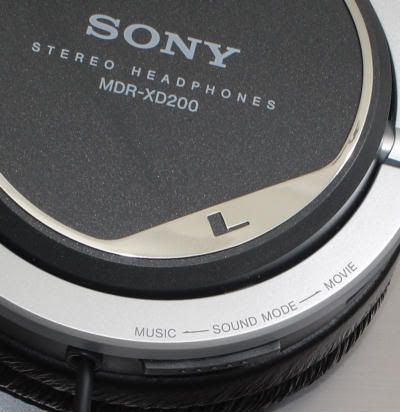
BUILD
Squeaks and creaks are expected on a £20 phone, and the XD200 does indeed squeak and creak a little. However, it is put together with a competent level of build quality for this budget. Structural parts are screwed on, and looked after this isn't liable to fall apart. Seen from a distance, the XD200 looks more expensive than it is. The 3m-ish single-sided cord is covered with an elastomer material, which is prone to certain amounts of snagging... but looks reasonably robust.
ISOLATION
The XD200 is closed, but doesn't really isolate. Provided your head gets a seal against the cushions, leakage is next to none, so your coworkers will remain undisturbed.
SIZE
While not quite at ATH-A900 bulk, the XD200 nevertheless sticks out quite a lot and is fairly large. Definitely home / office cans.
COMFORT
Pretty good for a closed phone with pleather earpads. The only flaw is that the lower rubber half of the headband doesn't have enough room to extend to provide a cushion before your head meets the hard plastic part of the band. The phone is lighter than most (220g quoted) and sits stably on the head. The asymmetrical earpads provide good placement and location around the ears.

FINAL WORDS
The low-end closed headphone market has a worthy new entry in the form of the MDR-XD200. While it's not quite a Beyerdynamic DT231, it is a smoother, warmer and agreeable alternative, with a neat party trick for those rap tracks. It's pretty efficient for a full sized can (much more so than the DT231), fairly comfy and it doesn't leak. Now if you'll excuse me, I have to go finish that angel-proof shelter... the Apocalypse is upon us.
UK residents can buy from Argos
Sony link (Japanese) : MDR-XD200
ADDENDUM
A wizard suggestion by a Hi-Fi designer lead to me opening up these phones. And some additional clarifications are in order.
First, the phones are semi-closed. There's a small gap around where the cushions sit, which is effectively open to the outside. This explains the lack of isolation, but because of the placing of the gap, it also explains the comparative lack of leakage to those situated beside the phone-wearer.
Secondly, the bass boost circuit is not electronic. There's a spring-loaded vent on the phone, situation within the inner earcup area which directly faces the ear.
The "Music" setting leaves this vent closed.
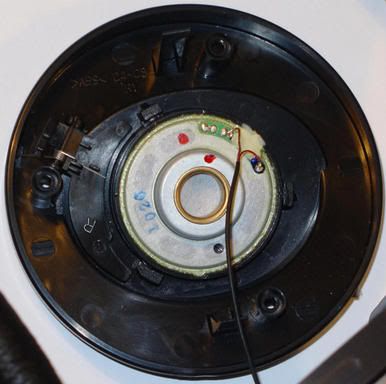
Sliding the switch to "Movie" lifts open the vent.
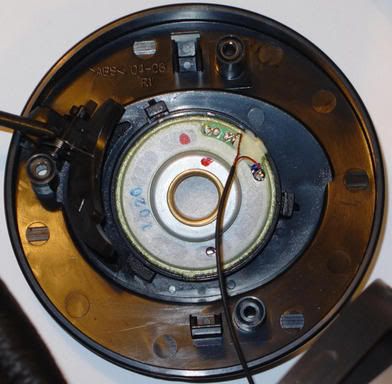
Fascinating, very simple and effective.
Sony isn't a company which I associate with good low-end closed headphones. The MDR-V500DJ (actually not so low-end in terms of what most people are willing to pay) is one of the few headphones that I have actually dumped in the bin. The very popular (in terms of sales to the general public) MDR-V300DJ is if anything even more crappy, with absolutely awful 'badly closed phone' acoustics. Just generally, low-end Sony headphones seem to be pretty dire. The newer-generation (open backed) MDR-G74SL was however a nice surprise, being an acceptable phone and better than I expected for a very low cost, mass-market portable phone.
Recently, a friend of mine asked me what he should buy for office use on a budget of £20 ($35~$40). I didn't really have a definite idea what to recommend, except for say "spend more", but one of the alternatives he presented to me was the brand new Sony MDR-XD200 (for £20). The new XD range has just come out in Japan, and I was quite surprised to see that they are available in the UK already. I nominated him for guinea pig role, and said he should buy the XD. He's not really what I would call a critical listener, so I was assuming that even if they were only marginally crappier than the MDR-G74SL, he'd probably be happy. So, we got together the next day and he turned out to be very pleased with the choice. I also had to have a listen out of my laptop, and...
"What was that?"
"What?"
"Did you just see four really underfed looking guys on horses go past?"
"What're you talking about?"
"Cloaked, one of them carrying a large farm implement?"
"Huh?"
"Um... Never mind."
These sounded good. REALLY good. Of course, my expectations were low but still... there was undeniably a hi-fi patina about these phones without all the bad things that usually accompany low-end Sony closed headphones. Three hours later, I got one for myself.


The cups look oval in most views of the XD series, but they are actually circular.
TECHNICAL
The closed-back, circumaural XD200 has 40mm drivers claimed to be 'long stroke'. Efficiency is a decent 102db/mw and the impedance is 70 ohms @ 1khz. The phone ships terminated with a 3.5mm jack, with a 6.5mm converter plug. The MDR-XD200 has angled drivers.
SOUND
It's actually got a very nice mild tone, which resolves more than sufficiently for a phone of this price yet doesn't display any traces of sibilance or nasty shrill highs. It's all quite a bit smoother than you expect for this budget. There is a tendency to gloss over some detail, but I can live with the tradeoff for this little money. Bass is very firmly planted with a good bloom without overextending into mush. Staging is less 2-D than some $200+ phones I've had. Although the staging is not large, environmental cues are certainly represented correctly. I can use words like 'instrument separation' without falling off my chair laughing. I have to say this is pretty disconcerting. I'm sitting here writing this post, listening directly out of my PC and I'm still looking out of the window, just in case the Seraphim start putting on an airshow.
SOUND MODE SWITCH
One of the unique selling points of the XD200 is the Sound Mode Switch on the underside of both the cups, which allow you to trigger 'music' or 'movie' mode. The music mode leaves the signal unaltered, while the movie mode introduces a rather unsophisticated bass boost circuit. Unsophisticated it may be, but it really works. It's mostly mid-bass, to introduce extra extended 'boom' to whatever you're listening to. If your listening style is of the less refined variety, of course there's nothing stopping you using it for music of course.

BUILD
Squeaks and creaks are expected on a £20 phone, and the XD200 does indeed squeak and creak a little. However, it is put together with a competent level of build quality for this budget. Structural parts are screwed on, and looked after this isn't liable to fall apart. Seen from a distance, the XD200 looks more expensive than it is. The 3m-ish single-sided cord is covered with an elastomer material, which is prone to certain amounts of snagging... but looks reasonably robust.
ISOLATION
The XD200 is closed, but doesn't really isolate. Provided your head gets a seal against the cushions, leakage is next to none, so your coworkers will remain undisturbed.
SIZE
While not quite at ATH-A900 bulk, the XD200 nevertheless sticks out quite a lot and is fairly large. Definitely home / office cans.
COMFORT
Pretty good for a closed phone with pleather earpads. The only flaw is that the lower rubber half of the headband doesn't have enough room to extend to provide a cushion before your head meets the hard plastic part of the band. The phone is lighter than most (220g quoted) and sits stably on the head. The asymmetrical earpads provide good placement and location around the ears.

FINAL WORDS
The low-end closed headphone market has a worthy new entry in the form of the MDR-XD200. While it's not quite a Beyerdynamic DT231, it is a smoother, warmer and agreeable alternative, with a neat party trick for those rap tracks. It's pretty efficient for a full sized can (much more so than the DT231), fairly comfy and it doesn't leak. Now if you'll excuse me, I have to go finish that angel-proof shelter... the Apocalypse is upon us.
UK residents can buy from Argos
Sony link (Japanese) : MDR-XD200
ADDENDUM
A wizard suggestion by a Hi-Fi designer lead to me opening up these phones. And some additional clarifications are in order.
First, the phones are semi-closed. There's a small gap around where the cushions sit, which is effectively open to the outside. This explains the lack of isolation, but because of the placing of the gap, it also explains the comparative lack of leakage to those situated beside the phone-wearer.
Secondly, the bass boost circuit is not electronic. There's a spring-loaded vent on the phone, situation within the inner earcup area which directly faces the ear.
The "Music" setting leaves this vent closed.

Sliding the switch to "Movie" lifts open the vent.

Fascinating, very simple and effective.
Saturday, January 22, 2005
The sort of K2 of the headphone world.
I don't think I can quite justify covering all the bases headphone-wise to include the Sennheiser Orpheus, so these two will have to do.
The spacialis(z?)ation problem is not going away afer pretty extensive burn-in so far. Let's hope it disappears during the next couple of weeks. I'm hoping that more extensive wear will perhaps help to 'dampen down' the cellulose baffles with moisture and body oils (let's all puke together) and get rid of some issues.
If not... well, the Q010 may be winging their way back to Japan again for repair. Even just listening to the phones by themselves for a long time, I can't quite agree at this time that the way it sounds is right. The way these phones resolve is something else, but there are what I consider major problems in staging.
The spacialis(z?)ation problem is not going away afer pretty extensive burn-in so far. Let's hope it disappears during the next couple of weeks. I'm hoping that more extensive wear will perhaps help to 'dampen down' the cellulose baffles with moisture and body oils (let's all puke together) and get rid of some issues.
If not... well, the Q010 may be winging their way back to Japan again for repair. Even just listening to the phones by themselves for a long time, I can't quite agree at this time that the way it sounds is right. The way these phones resolve is something else, but there are what I consider major problems in staging.
Friday, January 21, 2005
Case or Stand & Furoshiki?
I must say I was at first very underwhelmed by the packaging of the Qualia 010. They came in a white cardboard box. Not even a really nice cardboard box like the Sennheiser HD650. Not even just a nicely designed box like the iPod. But basically, a cardboard box.
Although I must admit I had a grin on my face when unboxing the 010 revealed that it was covered not by a plastic bag but by a white satin furoshiki. It's definitely a Japanese product <^_^>
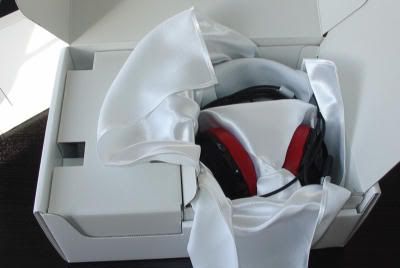
I then thought about the packaging of these high-end phones. With most of them, you get an elaborate presentation box. Sony's own MDR-R10, the Stax Omega II, the Audio-Technica ATH-W2002, not to mention Ultrasone's Edition 7 and others... they all ship in boxes that are not only useful to transport the phones in, but also make a statement about what you're getting.
Then OK, it occured to me that once you buy these things, most people will actually just use them at home and the case won't be used. So, the Qualia 010 approach of shipping a stand instead of a fancy case actually makes more sense. But making sense and making a statement are totally different things... and the Qualia range is supposed to be about making a statement.
I appreciate the stand, really. It's a sculptured, heavyweight, handsome thing that I can only find... ooh, 2 or so major design faults on. But I really would have liked an elaborate box WITH a stand and furoshiki. I mean, people will spend $2.5~$3K on these so an extra couple of hundred for a fancy case wouldn't kill the prospective buyer, would it?
Although I must admit I had a grin on my face when unboxing the 010 revealed that it was covered not by a plastic bag but by a white satin furoshiki. It's definitely a Japanese product <^_^>

I then thought about the packaging of these high-end phones. With most of them, you get an elaborate presentation box. Sony's own MDR-R10, the Stax Omega II, the Audio-Technica ATH-W2002, not to mention Ultrasone's Edition 7 and others... they all ship in boxes that are not only useful to transport the phones in, but also make a statement about what you're getting.
Then OK, it occured to me that once you buy these things, most people will actually just use them at home and the case won't be used. So, the Qualia 010 approach of shipping a stand instead of a fancy case actually makes more sense. But making sense and making a statement are totally different things... and the Qualia range is supposed to be about making a statement.
I appreciate the stand, really. It's a sculptured, heavyweight, handsome thing that I can only find... ooh, 2 or so major design faults on. But I really would have liked an elaborate box WITH a stand and furoshiki. I mean, people will spend $2.5~$3K on these so an extra couple of hundred for a fancy case wouldn't kill the prospective buyer, would it?
Wednesday, January 19, 2005
Qualia 010 is here.
I really don't know what to think at this stage regarding the sound. Something seems off to me going straight from the Omega II, but such jumps are usually misleading.
So in the meanwhile, here are some piccies. The Qualia 010 phone is a gorgeous (if a little flimsy feeling) combination of thermoset carbon fibre, magnesium, leather, etc. The 'nano-composite' diaphragms (a polymer alloy) promise exceptional accuracy.

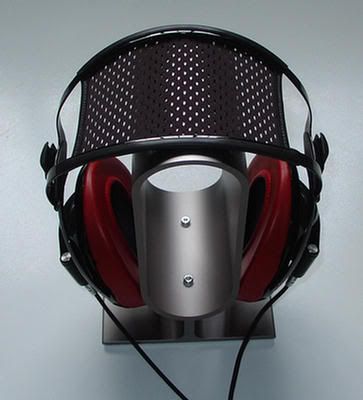
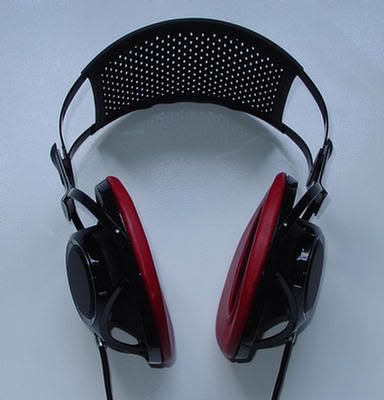
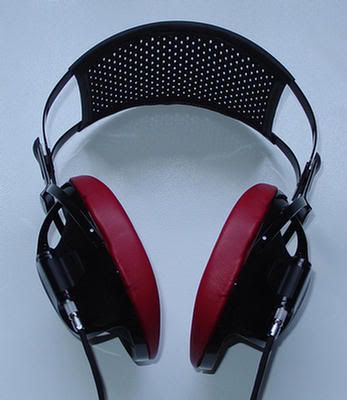
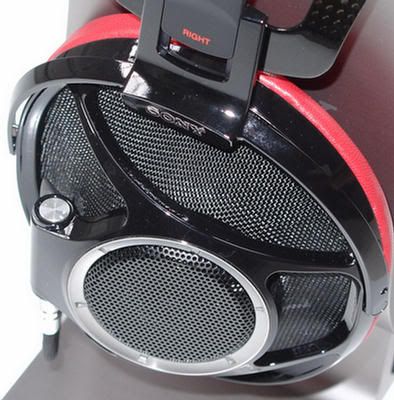
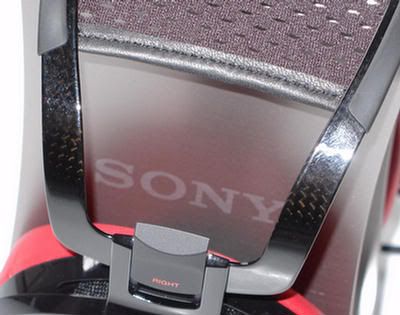
Here's one of the various places to buy if you're outside Japan or major cities in the US: Audiocubes
So in the meanwhile, here are some piccies. The Qualia 010 phone is a gorgeous (if a little flimsy feeling) combination of thermoset carbon fibre, magnesium, leather, etc. The 'nano-composite' diaphragms (a polymer alloy) promise exceptional accuracy.






Here's one of the various places to buy if you're outside Japan or major cities in the US: Audiocubes
Monday, January 17, 2005
100Gb Brick
Over the weekend, I managed to bump up my Creative JB3 to 100Gb. I mean, for a player that was originally designed for a 20Gb disk, this is pretty impressive. I've now got ~10,000 files on it, and although it is a bit of a handful on both Notmad Explorer and Creative Mediasource, it is all up and working.
Since I switched from iPod to going through a variety of other players for the purposes of curiousity, I've been backing up and culling / re-ripping my music from AAC / Apple Lossless to ~256K MP3. Say what you like about MP3, it's the only portable file format out there, and with the sheer variety of players at my disposal at any one time, any other format is too unmanageable... leading to multiple libraries which don't work for me. But what about sound quality testing? Simple, I retain a totally separate 20Gb-ish "test MP3/ATRAC/AAC/FLAC/Apple Lossless/WAV library" containing choice tunes for testing purposes. The test library is stored both on one of my laptops and on a Sony GigaVault, which means it's fully portable. As it may be apparent to you, I take all of this pretty seriously!
I've also spend a lot of time during the last couple of weeks on going through my library. The culled and reduced music library is 80Gb+ at the moment but might actually reduce by about another 10-20Gb or so due to dupe tracks I've discovered (thanks to iTunes for letting me do this in as painless a manner as possible), before I start adding new rips again. So it's expected that the JB3 can store all the CD's I've ripped from my music collection for a few months more at least. Incidentally, this ripping business is a real pain. I might give one of those ripping services a try soon, because the more time I spend on library management, the more CD's pile up to be ripped.
The JB3's a brick, but since the moment I've got this player I've loved it. It's got a flexible and usable (although not quite as good as the iPod) operating system, allows me to playlist and delete on the fly, records to hard disk at a quality that's not really much different from Minidisc (in a native MP3/WAV format, immediately uploadable) and lasts 15-24 hours on a charge. It also has Creative's proportionally accelerating fast forward, which is the next best thing to the iPod among all the other players I've had for scrolling through my longer podcasts. The new Zen Micro goes one better by copying the iPod, allowing pretty accurate time pointing by using the touchpad.
Although it's clearly antiquated I love the fact that the JB3 with upgrades keeps being the HDD DAP that I arguably use the most. I use it to record online broadcasts which aren't podded"to go" by just hooking it up to my laptops or my mixing console's Tape Out and hitting Record. It's still the player I travel with when going further afield, and I even used to use it as a home player thanks to the infrared remote control (I've programmed a learning remote with the codes), although with the introduction of the Squeezebox in my living and bedroom it's no longer needed in the role.
Sound's good too... more or less as good as the best portables curently on the market, and the basic 4-band EQ works for roughly correcting headphone response issues. Although while in normal use I never use the EAX modes they at least do what the labels say ("Arena", "Bathroom" etc actually sounds like the effect titles suggest), unlike Sony's V-Surround implementation for example which is a complete waste of time ("which version of your music coming through a drainpipe would you like?") .
I do hope, although probably in vain, for another firmware release for this player to keep it even more current. I'd also really like to have a folder-navigable display remote, unlike the current remote... I'd pay quite a lot of money for that, since it's the thing I miss most on the JB3.
Since I switched from iPod to going through a variety of other players for the purposes of curiousity, I've been backing up and culling / re-ripping my music from AAC / Apple Lossless to ~256K MP3. Say what you like about MP3, it's the only portable file format out there, and with the sheer variety of players at my disposal at any one time, any other format is too unmanageable... leading to multiple libraries which don't work for me. But what about sound quality testing? Simple, I retain a totally separate 20Gb-ish "test MP3/ATRAC/AAC/FLAC/Apple Lossless/WAV library" containing choice tunes for testing purposes. The test library is stored both on one of my laptops and on a Sony GigaVault, which means it's fully portable. As it may be apparent to you, I take all of this pretty seriously!
I've also spend a lot of time during the last couple of weeks on going through my library. The culled and reduced music library is 80Gb+ at the moment but might actually reduce by about another 10-20Gb or so due to dupe tracks I've discovered (thanks to iTunes for letting me do this in as painless a manner as possible), before I start adding new rips again. So it's expected that the JB3 can store all the CD's I've ripped from my music collection for a few months more at least. Incidentally, this ripping business is a real pain. I might give one of those ripping services a try soon, because the more time I spend on library management, the more CD's pile up to be ripped.
The JB3's a brick, but since the moment I've got this player I've loved it. It's got a flexible and usable (although not quite as good as the iPod) operating system, allows me to playlist and delete on the fly, records to hard disk at a quality that's not really much different from Minidisc (in a native MP3/WAV format, immediately uploadable) and lasts 15-24 hours on a charge. It also has Creative's proportionally accelerating fast forward, which is the next best thing to the iPod among all the other players I've had for scrolling through my longer podcasts. The new Zen Micro goes one better by copying the iPod, allowing pretty accurate time pointing by using the touchpad.
Although it's clearly antiquated I love the fact that the JB3 with upgrades keeps being the HDD DAP that I arguably use the most. I use it to record online broadcasts which aren't podded"to go" by just hooking it up to my laptops or my mixing console's Tape Out and hitting Record. It's still the player I travel with when going further afield, and I even used to use it as a home player thanks to the infrared remote control (I've programmed a learning remote with the codes), although with the introduction of the Squeezebox in my living and bedroom it's no longer needed in the role.
Sound's good too... more or less as good as the best portables curently on the market, and the basic 4-band EQ works for roughly correcting headphone response issues. Although while in normal use I never use the EAX modes they at least do what the labels say ("Arena", "Bathroom" etc actually sounds like the effect titles suggest), unlike Sony's V-Surround implementation for example which is a complete waste of time ("which version of your music coming through a drainpipe would you like?") .
I do hope, although probably in vain, for another firmware release for this player to keep it even more current. I'd also really like to have a folder-navigable display remote, unlike the current remote... I'd pay quite a lot of money for that, since it's the thing I miss most on the JB3.
Sunday, January 09, 2005
Shure E2c, Sennheiser PXC250 and Sony MDR-EX71 comparison
Prologue - Added January 2005:
Some time ago, I decided to do a comparison of two of the more frequently mentioned earphones on Head-Fi, along with a headphone that not so many have talked about. The Shure E2c has since it's introduction made a mark on the portable audio earphone market, and has emerged as a very serious competitor to the likes of Sony. The Sony MDR-EX71 is an update of the older EX70, the first consumer low-cost isolating in-earphone from a major manufacturer which didn't totally suck. The PXC250 is (or rather was at the time of the review) a newly-released noise-cancellation phone which was based on the company's PX200 closed mini headphone. So without further ado, here's the comparison...
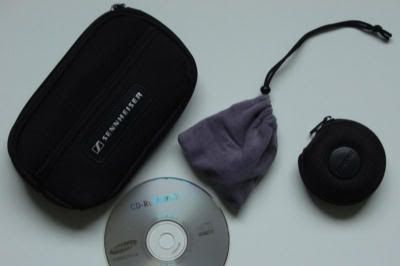
PXC250, MDR-EX71SL and E2c in their respective pouches.
Shure E2c
A warmish sound with reasonable extension (for a headphone… very good for an earphone!) in both directions. Bass was well represented but not overwhelming, mids were slightly upfront which contributed to the warmness, and the trebles were slightly recessed. On the whole a non fatiguing sound when heard at reasonable volumes. Not a big feeling of space with these phones, with a compacted soundstage. Accuracy is excellent.
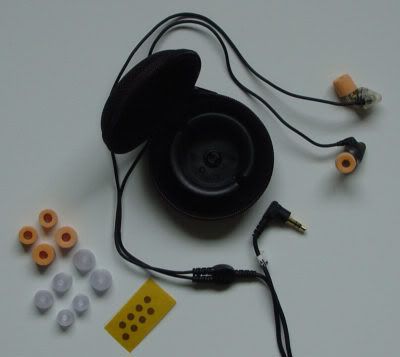
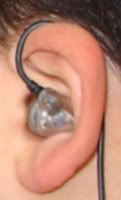
The phones ship with a well designed semi-hard case, small, medium and large silicone tips, small, medium and large expanding foam tips,, and a sheet of “earwax blockers” which are applied to the tips of the earphone tubes. The 3.5mm plug is a somewhat thicker than standard 90-degree type which may not fit all remotes. Shure provides a two-year warranty.
Volume reference: 30 out of 40 (iRiver MP3 CD player with 8mw/channel output volume setting for quite loud music)
Any of the portables powered this to a maximum deafening level. Overall a solid sound, generally suitable for all purpose use. Good for Pop and Rock, not so good for Classical
Sony MDR-EX71
In theory, this should have done well. It has a better extension at the tops than the E2, bass practically as deep/non blobby as the E2, and a wider soundstage. Accuracy is not that bad either. However the EX71 had a poor showing due to its overall cheap-feeling harsh sound. In some cases the snares sounded like oversized coke cans. The treble is harsh but clear, the mids are recessed and feel distant, and the bass is quite powerful and reasonably unbloated. The soundstage is somewhat wide feeling but completely 2-D.

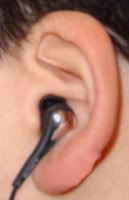
The phones ship with an simple yet clever plastic phone storage unit which encases only the earphones themselves, small, medium and large silicone tips, and a cloth pouch. SL models ship with a short cable and an additional extension cable. The 3.5mm plug is a ‘ultra slim/compact’ type which will fit all remotes. Sony provides a one-year warranty.
Volume reference: 35 out of 40
It’s noticeably less efficient than the E2c. I have to give credit to Sony for making definite changes to the sound and striving to improve their products, but they have gone to the opposite extreme with the EX71 and it is far too harsh. If they can dampen that a little, then you might have a great alternative to the E2c, especially for classical.
Sennheiser PXC250
This has a cooler and less upfront sound than the E2. Although the hiss of the amp/noise cancelling circuitry could be heard in silence, in normal use it should it should not be audible. The bass is very strong on this phone (more than any other phone) yet with minimal bloat, and sometimes in passages with long droning bass lines that could slightly overpower the rest of the sound. Drums are another matter and the PXC250 does this better than any other phone in this test. Bass drums came across almost tangibly. Accuracy is good, rendering complex passages with good composure. This is of course as long as the batteries last (2 AAA batteries in the noise cancelling stick, and they do last for a very long time). Without power it sounds like a very quiet PX200... Not that great.
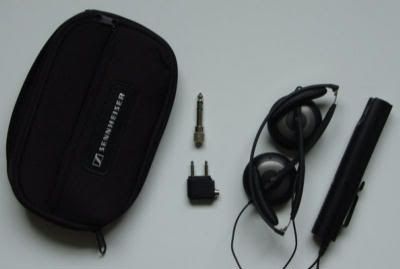
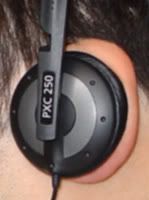
The phones ship with aircraft adapter, 6.4mm adaptor and a large cloth zip-up bag. The 3.5mm plug is a ‘slim’ type which will fit practically all remotes. The cancellation ‘stick’ has a belt clip which swivels 360 degrees with 90 degree detents for versatility. Sennheiser provides a two-year warranty.
Volume reference: 40 out of 40
Clearly not as efficient as the other phones, but not unusably quiet either with any of the portables. Europe-limited portables with 3mw and less will probably have problems driving these. The sound is quite easily the best of the three, very compatible with all music styles.
COMFORT / USABILITY
Phones rated on comfort, ability to pack/unpack easily, ability to disengage temporarily, and other general usability factors. The margins of the ratings are fairly small but there has to be a winner, and as the best thought out product for the above parameters the win goes to Sony.
3rd Place: The E2c was the worst for Comfort/Usability. This is because to get a good seal you must drive the phone a fair way into your ear, yet the phones’ ear tubes are quite wide, leading to some degree of discomfort. The discomfort is perfectly bearable though, and it doesn’t particularly get worse over time. You are expected to hook the earphone cables around your ears but they frequently fall off. If the E2c needs to be taken off momentarily, there is no easy way to let them hang around your neck. The only quick way without third party fixes or accessories is to unplug one ear. The cable tangles quite easily.
2nd Place: The PXC250’s profusion of cables and the extra cancellation ‘stick’ makes this the least portable of the three, and combined with cables that tangle quite easily, it is the least manageable in everyday operation. The headphone can be worn (somewhat uncomfortably) around the neck when not in use. The cancellation stick can be clipped around the belt or other such place. Phone comfort is very good for short and long term wearing and goes some way towards offsetting the problems in other areas.
1st place: The MDR-EX71SL has a short cord which works well for portables with remotes. The EX71LP has a regular longish cable. Because the EX71’s cable to the right ear goes behind the neck, the phones can be unplugged and left around the neck when temporarily not in use. The cable is resistant to tangling. The comfort of the EX71 is good, however since they do not go as far into the ear canal as the E2 they are very prone to being pulled out. Also due to the asymmetric nature of the cable, you cannot leave your remote dangling… It has to be secured somewhere or the left earbud will be regularly unplugged by accident. The plastic case is ingeniously simple, quick to use and useful.
ISOLATION
Assuming train, overland, reasonably crowded.
3rd Place: The MDR-EX71 doesn’t really isolate much in comparison to the other two phones. Conversations are still audible, and travelling noise is still very evident.
2nd Place: With the PXC250, all low frequency components (train rumblings, etc) are dramatically reduced. Conversations can still be heard and those happening close to the listener can intrude very clearly into the listening experience.
1st Place: The E2c (foam tips) uniformly cuts external sound by an impressive level. For general purpose portable isolation this is the most useful. However low frequency components are not attenuated as strongly as the PXC250.
OVERALL RANKINGS
3rd Place: Sony MDR-EX71. A distant third in terms of sound. Design and usability features score much higher, but not enough to stop it from coming last. It is the cheapest however, so that's not a disaster.
2nd Place: Sennheiser PXC250. The best sound of the trio but usability, portability and isolation issues persist to stop it winning. The most difficult to drive too, so users with weak or Euro-limited portable should avoid this unit. Noise cancellation is a very different experience, very nice for aircraft travel.
1st Place: Shure E2c (foam tips). It's got good sound albeit with a little bit off the treble, isolation is excellent and it's very portable. The puck shaped case is very handy. The E2c is easy to drive from even very weak portables. In overall terms I've no hesitation in declaring it the winner.
Although it doesn't win in all areas and is not the absolute best sounding, the Shure E2c in my opinion takes the top prize as the best solution for isolating portable ear gear in this price range. The tests did however impress upon me that the PXC250 is the best sounding (in the test noise cancellation was always on) with a wide variety of music. Although it was not a winner, a surprise was the EX71 which is very different to the 70. Whereas the previous MDR-EX70 was a cotton wool and syrup bloatfest, the EX71 beings a steely, somewhat harsh, distant but relatively (to the EX70 that is) controlled sound to the table.
Shure: E2c
Sennheiser: PXC250
Sony: MDR-EX71SL
Isolation versus cancellation
Many have said that the PXC250 doesn’t block out enough noise for their needs. Whether you choose cancellation or isolation really depends on what your needs are. And your needs will change according to how you travel. As I’ve established the PXC250 sounds better and may be more comfortable to some. So it still has an edge… You should consider using it if it fits your profile.
What the cancellation of the PXC250 does not do well is to block out frequencies above the mid-bass. If you fly, the E2 should be your choice if you travel Coach or Business regularly because you never know when the dreaded Screaming Baby will turn up right next to you. If you fly using corporate transport or First, then the PXC250 is your best bet. The closed design gets rid of the fatiguing air-con hiss and the cancellation eliminates engine drone, but doesn’t preclude you from hearing important announcements or your colleagues. Another area where the PXC250 performed poorly was in the London Underground. Frequently on the Underground there is an incredible howling noise caused by the rails, bogies and the enclosed space which the PXC250 cannot cancel out at all. On overland rail travel however the PXC250 is very effective, soaking up the travelling noises.
The cancellation of the PXC250 is interesting. Where the E2 and to a lesser extent the EX71 blocks out outside sound so it feels like sounds are in your ear, the PXC250’s cancellation seems to preserve the sense of space around you while dramatically reducing the outside noise. This is the reason that many feel that they are not getting reduction of unwanted sounds… yet a quick release of one of the earcups will tell you that a considerable amount of noise is being attenuated.
A warmish sound with reasonable extension (for a headphone… very good for an earphone!) in both directions. Bass was well represented but not overwhelming, mids were slightly upfront which contributed to the warmness, and the trebles were slightly recessed. On the whole a non fatiguing sound when heard at reasonable volumes. Not a big feeling of space with these phones, with a compacted soundstage. Accuracy is excellent.


The phones ship with a well designed semi-hard case, small, medium and large silicone tips, small, medium and large expanding foam tips,, and a sheet of “earwax blockers” which are applied to the tips of the earphone tubes. The 3.5mm plug is a somewhat thicker than standard 90-degree type which may not fit all remotes. Shure provides a two-year warranty.
Volume reference: 30 out of 40 (iRiver MP3 CD player with 8mw/channel output volume setting for quite loud music)
Any of the portables powered this to a maximum deafening level. Overall a solid sound, generally suitable for all purpose use. Good for Pop and Rock, not so good for Classical
Sony MDR-EX71
In theory, this should have done well. It has a better extension at the tops than the E2, bass practically as deep/non blobby as the E2, and a wider soundstage. Accuracy is not that bad either. However the EX71 had a poor showing due to its overall cheap-feeling harsh sound. In some cases the snares sounded like oversized coke cans. The treble is harsh but clear, the mids are recessed and feel distant, and the bass is quite powerful and reasonably unbloated. The soundstage is somewhat wide feeling but completely 2-D.


The phones ship with an simple yet clever plastic phone storage unit which encases only the earphones themselves, small, medium and large silicone tips, and a cloth pouch. SL models ship with a short cable and an additional extension cable. The 3.5mm plug is a ‘ultra slim/compact’ type which will fit all remotes. Sony provides a one-year warranty.
Volume reference: 35 out of 40
It’s noticeably less efficient than the E2c. I have to give credit to Sony for making definite changes to the sound and striving to improve their products, but they have gone to the opposite extreme with the EX71 and it is far too harsh. If they can dampen that a little, then you might have a great alternative to the E2c, especially for classical.
Sennheiser PXC250
This has a cooler and less upfront sound than the E2. Although the hiss of the amp/noise cancelling circuitry could be heard in silence, in normal use it should it should not be audible. The bass is very strong on this phone (more than any other phone) yet with minimal bloat, and sometimes in passages with long droning bass lines that could slightly overpower the rest of the sound. Drums are another matter and the PXC250 does this better than any other phone in this test. Bass drums came across almost tangibly. Accuracy is good, rendering complex passages with good composure. This is of course as long as the batteries last (2 AAA batteries in the noise cancelling stick, and they do last for a very long time). Without power it sounds like a very quiet PX200... Not that great.


The phones ship with aircraft adapter, 6.4mm adaptor and a large cloth zip-up bag. The 3.5mm plug is a ‘slim’ type which will fit practically all remotes. The cancellation ‘stick’ has a belt clip which swivels 360 degrees with 90 degree detents for versatility. Sennheiser provides a two-year warranty.
Volume reference: 40 out of 40
Clearly not as efficient as the other phones, but not unusably quiet either with any of the portables. Europe-limited portables with 3mw and less will probably have problems driving these. The sound is quite easily the best of the three, very compatible with all music styles.
COMFORT / USABILITY
Phones rated on comfort, ability to pack/unpack easily, ability to disengage temporarily, and other general usability factors. The margins of the ratings are fairly small but there has to be a winner, and as the best thought out product for the above parameters the win goes to Sony.
3rd Place: The E2c was the worst for Comfort/Usability. This is because to get a good seal you must drive the phone a fair way into your ear, yet the phones’ ear tubes are quite wide, leading to some degree of discomfort. The discomfort is perfectly bearable though, and it doesn’t particularly get worse over time. You are expected to hook the earphone cables around your ears but they frequently fall off. If the E2c needs to be taken off momentarily, there is no easy way to let them hang around your neck. The only quick way without third party fixes or accessories is to unplug one ear. The cable tangles quite easily.
2nd Place: The PXC250’s profusion of cables and the extra cancellation ‘stick’ makes this the least portable of the three, and combined with cables that tangle quite easily, it is the least manageable in everyday operation. The headphone can be worn (somewhat uncomfortably) around the neck when not in use. The cancellation stick can be clipped around the belt or other such place. Phone comfort is very good for short and long term wearing and goes some way towards offsetting the problems in other areas.
1st place: The MDR-EX71SL has a short cord which works well for portables with remotes. The EX71LP has a regular longish cable. Because the EX71’s cable to the right ear goes behind the neck, the phones can be unplugged and left around the neck when temporarily not in use. The cable is resistant to tangling. The comfort of the EX71 is good, however since they do not go as far into the ear canal as the E2 they are very prone to being pulled out. Also due to the asymmetric nature of the cable, you cannot leave your remote dangling… It has to be secured somewhere or the left earbud will be regularly unplugged by accident. The plastic case is ingeniously simple, quick to use and useful.
ISOLATION
Assuming train, overland, reasonably crowded.
3rd Place: The MDR-EX71 doesn’t really isolate much in comparison to the other two phones. Conversations are still audible, and travelling noise is still very evident.
2nd Place: With the PXC250, all low frequency components (train rumblings, etc) are dramatically reduced. Conversations can still be heard and those happening close to the listener can intrude very clearly into the listening experience.
1st Place: The E2c (foam tips) uniformly cuts external sound by an impressive level. For general purpose portable isolation this is the most useful. However low frequency components are not attenuated as strongly as the PXC250.
OVERALL RANKINGS
3rd Place: Sony MDR-EX71. A distant third in terms of sound. Design and usability features score much higher, but not enough to stop it from coming last. It is the cheapest however, so that's not a disaster.
2nd Place: Sennheiser PXC250. The best sound of the trio but usability, portability and isolation issues persist to stop it winning. The most difficult to drive too, so users with weak or Euro-limited portable should avoid this unit. Noise cancellation is a very different experience, very nice for aircraft travel.
1st Place: Shure E2c (foam tips). It's got good sound albeit with a little bit off the treble, isolation is excellent and it's very portable. The puck shaped case is very handy. The E2c is easy to drive from even very weak portables. In overall terms I've no hesitation in declaring it the winner.
Although it doesn't win in all areas and is not the absolute best sounding, the Shure E2c in my opinion takes the top prize as the best solution for isolating portable ear gear in this price range. The tests did however impress upon me that the PXC250 is the best sounding (in the test noise cancellation was always on) with a wide variety of music. Although it was not a winner, a surprise was the EX71 which is very different to the 70. Whereas the previous MDR-EX70 was a cotton wool and syrup bloatfest, the EX71 beings a steely, somewhat harsh, distant but relatively (to the EX70 that is) controlled sound to the table.
Shure: E2c
Sennheiser: PXC250
Sony: MDR-EX71SL
Isolation versus cancellation
Many have said that the PXC250 doesn’t block out enough noise for their needs. Whether you choose cancellation or isolation really depends on what your needs are. And your needs will change according to how you travel. As I’ve established the PXC250 sounds better and may be more comfortable to some. So it still has an edge… You should consider using it if it fits your profile.
What the cancellation of the PXC250 does not do well is to block out frequencies above the mid-bass. If you fly, the E2 should be your choice if you travel Coach or Business regularly because you never know when the dreaded Screaming Baby will turn up right next to you. If you fly using corporate transport or First, then the PXC250 is your best bet. The closed design gets rid of the fatiguing air-con hiss and the cancellation eliminates engine drone, but doesn’t preclude you from hearing important announcements or your colleagues. Another area where the PXC250 performed poorly was in the London Underground. Frequently on the Underground there is an incredible howling noise caused by the rails, bogies and the enclosed space which the PXC250 cannot cancel out at all. On overland rail travel however the PXC250 is very effective, soaking up the travelling noises.
The cancellation of the PXC250 is interesting. Where the E2 and to a lesser extent the EX71 blocks out outside sound so it feels like sounds are in your ear, the PXC250’s cancellation seems to preserve the sense of space around you while dramatically reducing the outside noise. This is the reason that many feel that they are not getting reduction of unwanted sounds… yet a quick release of one of the earcups will tell you that a considerable amount of noise is being attenuated.
Skullcandy LINK Cellular Handsfree converter
(review from a while back)

Not an anorexic redneck, but Skullcandy's logo.
Being such a dynamic and successful entrepreneur (pause to laugh hysterically, then cry) yet with a craving to listen to portable audio, I have frequent problems in missing calls as I'm listening, especially when I'm using isolating phones. My hunt was for a handsfree unit that would act as an audio/phone mixer in order to allow me to listen to the portable audio unit while still allowing me to answer calls. My searches turned up the Skullcandy LINK handsfree unit. They manufacture not only the unit I'm reviewing here, but also those with wired-in headphones of the earbud and neckband variety. I don't think any card carrying Head-Fi member would be buying those, would you? So it was the LINK model with a headphone jack that I ordered for the Ericsson T610, my primary phone.
How it works is pretty simple. It comes with a socket coming out of the metallised olive green coloured LINK for you to plug your phone into. Then there are two connectors coming out of the other end via a longish wire, a standard 3.5mm jack plug for your audio player, and the other connector will be one of a variety of possible connectors depending on your phone.
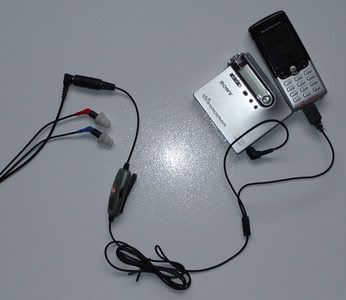
The LINK unit has a microphone, a call answer button and a volume control. It has a clip at the back to attach reasonably securely to somewhere around your collar area.
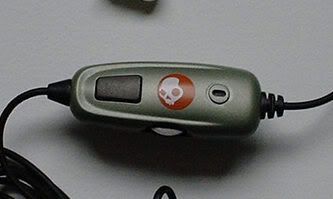
In normal use, you turn up the volume control on the LINK unit so that you can hear the music from your player. The volume control only affects the signal from the player. If an incoming call comes in, you're alerted via the ringing sound (will differ according to mobile phone) mixed into the audio signal. You turn down the volume control on the LINK unit and press the call answer button. Then the LINK behaves like any other handsfree unit. After your call has ended, you just turn the volume back up.
Is it expensive? No. It cost me under £20. So in the US that's probably $20.
Does it work? Yes.
Is it easy to use? Yes. Just spin the volume dial when you get a call, then hit the answer button. By accident or by design, the volume potentiometer seems to do the majority of its work within about a 10 minute arc which is a usefully short throw. Obviously for that reason too, precise volume adjustment of your audio signal can be tricky.
Does it affect the audio signal? I'm sure it does, it's pretty cheap electronics all around.
Particularly noticeably? No I don't think so.
Is it convenient? It's a lot better than fumbling in your pockets for the phone, pulling out your Etymotics/Shures with the grimace that I'm sure we all make, talking, then re-inserting said phones pulling up your ear in the manner of some sort of obscure cult greeting.
I think I can see a problem with cables... You'd be right. The fixed Y cable split between the phone and the player is too short. If your player works from a remote, an extension cable is a necessity. The same is true if you want to store your player some distance from the phone.
Other problems? There was one time when the other party couldn't hear me talking. However it worked again when I reconnected the Skullcandy to the phone. If you own several phones with different handsfree connections, you need a different LINK for each as they don’t sell adaptors nor a universal model.
Any useful goodies with it? You do get a Minidisc player-sized PVC bag with the Skullcandy logo on it.
Verdict: It's simple and it works.
Links:
Skullcandy

Not an anorexic redneck, but Skullcandy's logo.
Being such a dynamic and successful entrepreneur (pause to laugh hysterically, then cry) yet with a craving to listen to portable audio, I have frequent problems in missing calls as I'm listening, especially when I'm using isolating phones. My hunt was for a handsfree unit that would act as an audio/phone mixer in order to allow me to listen to the portable audio unit while still allowing me to answer calls. My searches turned up the Skullcandy LINK handsfree unit. They manufacture not only the unit I'm reviewing here, but also those with wired-in headphones of the earbud and neckband variety. I don't think any card carrying Head-Fi member would be buying those, would you? So it was the LINK model with a headphone jack that I ordered for the Ericsson T610, my primary phone.
How it works is pretty simple. It comes with a socket coming out of the metallised olive green coloured LINK for you to plug your phone into. Then there are two connectors coming out of the other end via a longish wire, a standard 3.5mm jack plug for your audio player, and the other connector will be one of a variety of possible connectors depending on your phone.

The LINK unit has a microphone, a call answer button and a volume control. It has a clip at the back to attach reasonably securely to somewhere around your collar area.

In normal use, you turn up the volume control on the LINK unit so that you can hear the music from your player. The volume control only affects the signal from the player. If an incoming call comes in, you're alerted via the ringing sound (will differ according to mobile phone) mixed into the audio signal. You turn down the volume control on the LINK unit and press the call answer button. Then the LINK behaves like any other handsfree unit. After your call has ended, you just turn the volume back up.
Is it expensive? No. It cost me under £20. So in the US that's probably $20.
Does it work? Yes.
Is it easy to use? Yes. Just spin the volume dial when you get a call, then hit the answer button. By accident or by design, the volume potentiometer seems to do the majority of its work within about a 10 minute arc which is a usefully short throw. Obviously for that reason too, precise volume adjustment of your audio signal can be tricky.
Does it affect the audio signal? I'm sure it does, it's pretty cheap electronics all around.
Particularly noticeably? No I don't think so.
Is it convenient? It's a lot better than fumbling in your pockets for the phone, pulling out your Etymotics/Shures with the grimace that I'm sure we all make, talking, then re-inserting said phones pulling up your ear in the manner of some sort of obscure cult greeting.
I think I can see a problem with cables... You'd be right. The fixed Y cable split between the phone and the player is too short. If your player works from a remote, an extension cable is a necessity. The same is true if you want to store your player some distance from the phone.
Other problems? There was one time when the other party couldn't hear me talking. However it worked again when I reconnected the Skullcandy to the phone. If you own several phones with different handsfree connections, you need a different LINK for each as they don’t sell adaptors nor a universal model.
Any useful goodies with it? You do get a Minidisc player-sized PVC bag with the Skullcandy logo on it.
Verdict: It's simple and it works.
Links:
Skullcandy
Sony MDR-V500DJ headphones
Sony's entry-level 'pro DJ lookalike' headphones create quite an impression. Presented in stealth matt black, these cool looking supra-aural, closed headphones definitely gives you the look of the DJ without going all-out with the range topping MDR-V700DJ. They fold for portability and are exceedingly well made. The plastics are of high quality and the phone generally exudes a reassuring feel of solid manufacture. The V500DJ is reasonably comfortable to wear sitting fairly lightly on the head, and does not exert an unduly high pressure on the ears.
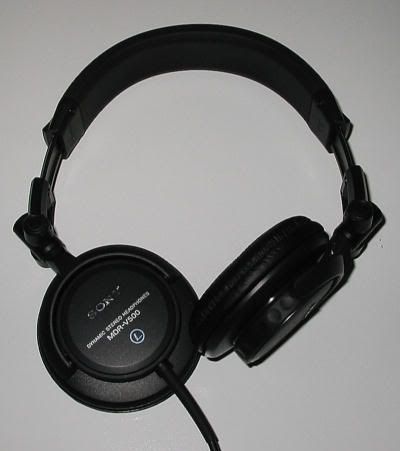
SOUND
In previous reviews, I've mused on the midrange, relative resolution, soundstaging, etc of the phones. For the MDR-V500DJ however, I'm glad to say that I can describe the sound in 1 succinct word.
That word is: Shit.
The phones are surprisingly low in efficiency for a DJ-style phone intended to pump out the beats. The sound is scratchy and there is no real bass extension or power.
OTHER SECTIONS
Bearing in mind the above, I think we can cut all of those out and proceed to...
FINAL WORDS
These are the only headphones which I have actually thrown in the wastebasket (and I paid retail) after a period of trying my best to do something useful with them, because I couldn't really sell them to anyone else on Head-Fi with a clear conscience and I couldn't bear to inflict them on anyone I knew. They're extremely well built, stylish and relatively lightweight phones which happen to sound really bad. As for a family resemblance, it's big brother the MDR-V700DJ has nothing sonically in common with the V500DJ. Avoid like the plague.
SonyStyle Link

SOUND
In previous reviews, I've mused on the midrange, relative resolution, soundstaging, etc of the phones. For the MDR-V500DJ however, I'm glad to say that I can describe the sound in 1 succinct word.
That word is: Shit.
The phones are surprisingly low in efficiency for a DJ-style phone intended to pump out the beats. The sound is scratchy and there is no real bass extension or power.
OTHER SECTIONS
Bearing in mind the above, I think we can cut all of those out and proceed to...
FINAL WORDS
These are the only headphones which I have actually thrown in the wastebasket (and I paid retail) after a period of trying my best to do something useful with them, because I couldn't really sell them to anyone else on Head-Fi with a clear conscience and I couldn't bear to inflict them on anyone I knew. They're extremely well built, stylish and relatively lightweight phones which happen to sound really bad. As for a family resemblance, it's big brother the MDR-V700DJ has nothing sonically in common with the V500DJ. Avoid like the plague.
SonyStyle Link
Audio-Technica ATH-D1000 digital upsampling headphone
The ATH-D1000 is digital-only phone, which takes an optical TOSLINK signal, upsamples it to 96khz, amps it and plays it back.
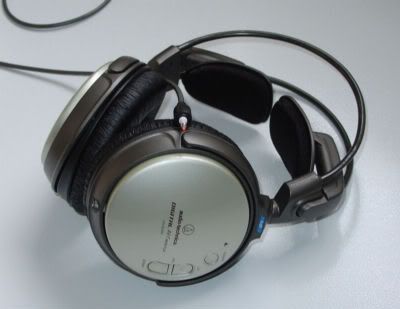
That's right, optical input only. No analog headphone jack on this baby.
I bought it as a gimmick given my Audio-Technica higher-end completist leanings. I was intrigued at how a digital upsampling phone would sound, and have to say I was in all honesty not expecting much. Opening the package revealed the now familiar to me ATH-A (A500/700/900) series lines with the exception of the battery compartment on top of the ‘3D Wings’ and the buttons on the side. Unlike the ATH-A900 and higher models by the way, the earcups are plastic. Tapping the earcups I was a bit disappointed. I expected at least the A900 build of alloy. I consoled myself with the thought that plastic it may be, but it's a very high quality level of finish. The earpads are the HP-A900, exactly the same as the A500/700/900.
The phone ships with a mini TOSLINK to TOSLINK cable. You can use this to connect directly to a deck with an optical out. You can also use the phone with portable, but you’ll need a mini TOSLINK – mini TOSLINK cable. As I said, the phone upsamples the signal to 96khz before squirting it through a digital amp and then through an D-A converter. I have no idea how the upsampling affects the sound, as there’s no way to turn it off. Audio-Technica quotes a BTL digital amp. The phone works with 44.1, 48 and 32khz signals. The phone is powered by 2 AAA Ni-Mh rechargeable batteries which are charged in approx 2.5 hours by the included, very neat world-voltage AAA/AA charger.
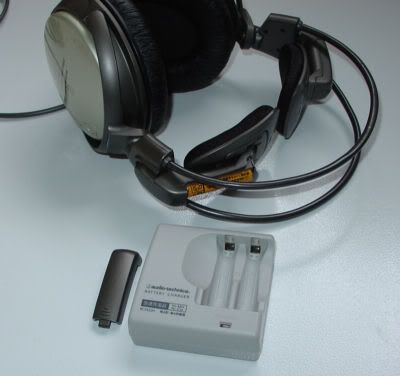
Comfort wise, the phones are in line with the Audio-Technica A-series. That's to be expected since the chassis is the same as the ATH-A900. It’s very good for a closed phone, although those in hot climates may feel that it’s a little too enclosed for their needs. Getting back to the looks and materials, cosmetically this phone is even less than the A900. It seems that what you get for your money over the $200 (from Audiocubes) ATH-A900 is the ‘custom-developed for D1000’ driver, the added electronics and the battery charger. $650 for a nearly all-plastic phone… The dissatisfaction was mounting by the time I put them on my head. Using a $30 Sony mini-to-mini cable I hooked it up to the digital source I had handy at the time (the iRiver iMP-550), turned it on (the on button requires a ‘double-click’) and pressed play.
As I said I wasn’t expecting much.
My next words were: “Holy Shit”.
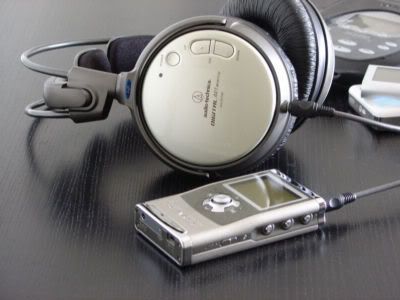
Hook it up directly to portable optical outs, not just home sources.
What I definitely was not expecting was a technical performance that’s just a couple of notches below W2002/RS-1 with middle-class amping. And that’s out of an iRiver to start with. OK, there's a bit more hiss than good amps should have, but by jebus it's genuinely bordering on high end performance.
The soundstaging on the D1000 could be described as ‘headphones realistic’… with most sounds circling your circling your head, not too far away but well separated. On upbeat tracks, the bass is fairly tight, very punchy, elastic and definitely there, providing a driving compliment to the higher frequencies but never overriding it. This is the first new generation Audio-Technica phone on which I’ve heard the “DADS” (Dynamic Air Damping System, or Got To Think Of A Marketing BS Acronym That’s Not Been Used Before) being implemented really well. Kick drums come across as described… with a kick, not a ‘shlup’ like some so-called hi-fi phones. Sometimes there’s a mid-bass balloon that could possibly get in the way of the music, but it never crosses the ‘dum-bass’ border. There’s no way to deny that the growling bass in “Battle Without Honor Or Humanity” for example adds to the casual menace of this track and that the kick drums are very effectively rendered. But the midrange and treble is the really killer part of this phone. As far as I can see, there’s nothing wrong with it. It’s neither recessed nor emphasised and it’s done with a beguiling sense of smoothness while retaining plenty of detail. You will not find a trace of sibilance unless it’s in the recording. This comes to the fore while listening to the Maxim Vengerov ("Vengerov plays Bach Schedrin Ysaye") and Talvin Singh ("OK") recording. It attacks when called upon but is otherwise incredibly well-tempered.
The overriding nature of this phone is a ‘natural’ sound. What the hell is a ‘natural’ sound? Transparent, bright-ish yet without a trace of added sibilance, decent but not ultra-wide staging, and a low end fully capable of adding weight to a performance. I would call it natural. Either way it’s a rendition style that allows the quality of the sounds to be apparent yet for music to flow: for you to be able to ‘listen to the music’ instead of ‘hearing the sounds’. It’s a bit like an old comfy pair of slippers that nevertheless still manages to look new. The sound is quite lively, yet it’s not natively aggressive. Neither is it soporific. And believe it or not, the ATH-D1000 does deliver the general Stax Omega II / SRM-007t sonic flavour, albeit without the resolution (and therefore less of that transparency). However that's not to say that the phone lacks in transparency given general dynamic phone performance: Poor recordings are exposed for what they are.
Is it worth it? To me an AKG K271S ($180) with a Ray Samuels XP-7 ($500) and a $50 interconnect is technically infinitesimally inferior to the ATH-D1000 and a $30 Sony optical cable, while the D1000 is musically considerably superior. There’s obviously no provision for opamp-rolling and whatever to play with the sound, but I don’t believe there’s any need to play with it. It’s very good the way it is.
So, it’s an upsampling DAC, amp and excellent phone all-in-one, at a price that’s somewhat below what you’d expect to pay for such a combination. If you’re looking at building from scratch with a discount-store mid-fi home deck and don’t expect to upgrade for a while, you could do a lot worse and spend a lot more than simply pairing it with the ATH-D1000. Even better if you own a Discman with optical out… these will really pep up the sound and more importantly be far more portable than dragging an XP-7 (or equivalent) around with you.
While the exact ‘value for money’ quotient is out to the jury for these phones, I think that the phones give a polished and hugely entertaining performance, and the DAC-amp in these phones really work. The sonic performance makes it definitely a master and not a jack of all trades, and it can definitely punch with the best of amp+phone combinations in this price range.
In my opinion, the all-rounder phone market has a new, unique and very serious contender in the shape of the ATH-D1000.
Manufacturer Link (Japanese)
Buy here: Audiocubes

That's right, optical input only. No analog headphone jack on this baby.
I bought it as a gimmick given my Audio-Technica higher-end completist leanings. I was intrigued at how a digital upsampling phone would sound, and have to say I was in all honesty not expecting much. Opening the package revealed the now familiar to me ATH-A (A500/700/900) series lines with the exception of the battery compartment on top of the ‘3D Wings’ and the buttons on the side. Unlike the ATH-A900 and higher models by the way, the earcups are plastic. Tapping the earcups I was a bit disappointed. I expected at least the A900 build of alloy. I consoled myself with the thought that plastic it may be, but it's a very high quality level of finish. The earpads are the HP-A900, exactly the same as the A500/700/900.
The phone ships with a mini TOSLINK to TOSLINK cable. You can use this to connect directly to a deck with an optical out. You can also use the phone with portable, but you’ll need a mini TOSLINK – mini TOSLINK cable. As I said, the phone upsamples the signal to 96khz before squirting it through a digital amp and then through an D-A converter. I have no idea how the upsampling affects the sound, as there’s no way to turn it off. Audio-Technica quotes a BTL digital amp. The phone works with 44.1, 48 and 32khz signals. The phone is powered by 2 AAA Ni-Mh rechargeable batteries which are charged in approx 2.5 hours by the included, very neat world-voltage AAA/AA charger.

Comfort wise, the phones are in line with the Audio-Technica A-series. That's to be expected since the chassis is the same as the ATH-A900. It’s very good for a closed phone, although those in hot climates may feel that it’s a little too enclosed for their needs. Getting back to the looks and materials, cosmetically this phone is even less than the A900. It seems that what you get for your money over the $200 (from Audiocubes) ATH-A900 is the ‘custom-developed for D1000’ driver, the added electronics and the battery charger. $650 for a nearly all-plastic phone… The dissatisfaction was mounting by the time I put them on my head. Using a $30 Sony mini-to-mini cable I hooked it up to the digital source I had handy at the time (the iRiver iMP-550), turned it on (the on button requires a ‘double-click’) and pressed play.
As I said I wasn’t expecting much.
My next words were: “Holy Shit”.

Hook it up directly to portable optical outs, not just home sources.
What I definitely was not expecting was a technical performance that’s just a couple of notches below W2002/RS-1 with middle-class amping. And that’s out of an iRiver to start with. OK, there's a bit more hiss than good amps should have, but by jebus it's genuinely bordering on high end performance.
The soundstaging on the D1000 could be described as ‘headphones realistic’… with most sounds circling your circling your head, not too far away but well separated. On upbeat tracks, the bass is fairly tight, very punchy, elastic and definitely there, providing a driving compliment to the higher frequencies but never overriding it. This is the first new generation Audio-Technica phone on which I’ve heard the “DADS” (Dynamic Air Damping System, or Got To Think Of A Marketing BS Acronym That’s Not Been Used Before) being implemented really well. Kick drums come across as described… with a kick, not a ‘shlup’ like some so-called hi-fi phones. Sometimes there’s a mid-bass balloon that could possibly get in the way of the music, but it never crosses the ‘dum-bass’ border. There’s no way to deny that the growling bass in “Battle Without Honor Or Humanity” for example adds to the casual menace of this track and that the kick drums are very effectively rendered. But the midrange and treble is the really killer part of this phone. As far as I can see, there’s nothing wrong with it. It’s neither recessed nor emphasised and it’s done with a beguiling sense of smoothness while retaining plenty of detail. You will not find a trace of sibilance unless it’s in the recording. This comes to the fore while listening to the Maxim Vengerov ("Vengerov plays Bach Schedrin Ysaye") and Talvin Singh ("OK") recording. It attacks when called upon but is otherwise incredibly well-tempered.
The overriding nature of this phone is a ‘natural’ sound. What the hell is a ‘natural’ sound? Transparent, bright-ish yet without a trace of added sibilance, decent but not ultra-wide staging, and a low end fully capable of adding weight to a performance. I would call it natural. Either way it’s a rendition style that allows the quality of the sounds to be apparent yet for music to flow: for you to be able to ‘listen to the music’ instead of ‘hearing the sounds’. It’s a bit like an old comfy pair of slippers that nevertheless still manages to look new. The sound is quite lively, yet it’s not natively aggressive. Neither is it soporific. And believe it or not, the ATH-D1000 does deliver the general Stax Omega II / SRM-007t sonic flavour, albeit without the resolution (and therefore less of that transparency). However that's not to say that the phone lacks in transparency given general dynamic phone performance: Poor recordings are exposed for what they are.
Is it worth it? To me an AKG K271S ($180) with a Ray Samuels XP-7 ($500) and a $50 interconnect is technically infinitesimally inferior to the ATH-D1000 and a $30 Sony optical cable, while the D1000 is musically considerably superior. There’s obviously no provision for opamp-rolling and whatever to play with the sound, but I don’t believe there’s any need to play with it. It’s very good the way it is.
So, it’s an upsampling DAC, amp and excellent phone all-in-one, at a price that’s somewhat below what you’d expect to pay for such a combination. If you’re looking at building from scratch with a discount-store mid-fi home deck and don’t expect to upgrade for a while, you could do a lot worse and spend a lot more than simply pairing it with the ATH-D1000. Even better if you own a Discman with optical out… these will really pep up the sound and more importantly be far more portable than dragging an XP-7 (or equivalent) around with you.
While the exact ‘value for money’ quotient is out to the jury for these phones, I think that the phones give a polished and hugely entertaining performance, and the DAC-amp in these phones really work. The sonic performance makes it definitely a master and not a jack of all trades, and it can definitely punch with the best of amp+phone combinations in this price range.
In my opinion, the all-rounder phone market has a new, unique and very serious contender in the shape of the ATH-D1000.
Manufacturer Link (Japanese)
Buy here: Audiocubes
Stax SR-001 MK II electrostatic in-ear phones
(reposted/edited from old Head-Fi post)
Electrostatic in-the earspeakers. An intriguing concept, don't you think? The magic of electrostatics... The thrill of 580V pulsing away millimeters from your eardrum... So what do you expect out of an electrostatic in-earspeaker? Glassy highs, astonishing detail, and a lack of bass? Well I did. Imagine my complete surprise when the SR-001 totally subverted my supposition.
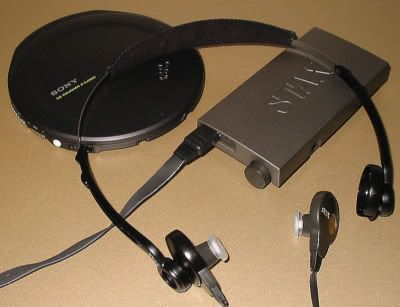
(pictured with Sony D-EJ2000 discman)
The SR-001 Mk II is one of Stax's 'complete kit' line-ups, akin to the SR-3030 driver + earspeaker kit for example. You get everything you need to start listening. But you don't have to buy complete. There is a different driver available for the earspeaker part of the SR-001, and you can buy the two bits separately like any other speaker/driver in the Stax range.
The driver unit isn’t that big, perhaps slightly longer than a cigarette packet, and takes AA batteries. It has one control, the on/off and volume knob. It's one of those knobs which click on and off at the start of rotation. It's got the socket for the earspeaker, and a socket for a mains adaptor. The unit drives the earspeakers to ample volume in most circumstances with any source. I tried the Line Out of my discman, and the headphone out of my minidisc player, both very wimpy in terms of headphone output, and was happy with the results under most portable conditions. The earspeakers aren’t sealed, so you can hear pretty much everything going on around you.
The earspeakers have tubes extending out, which sticks into your ears. The tips are soft silicone for comfort. The earspeakers come with a headband which you can attach or detach according to your preferences.
SOUND
The sound was what really surprised me to start with. I was expecting glassy trebles... And I didn't get it. Treble is noticeably rolled off, to an extent that cymbals and such sounds take something of a back seat in the overall mix. The same can't be said for the bass, which is snappy and big. So yes, this is an electrostatic earspeaker with powerful bass and a recessed treble. You may indeed be a little confused.
Midrange performance is fluid and very, very nice. It's perhaps the best part of this earphone... and it's arguably better than any other earphone out there. The lack of high treble puts something of a muffler on the overall rendition, but the mids and punchy lows really make up for this. Joaquin Rodrigo's Concierto De Aranjuez came across with clearly superior clarity in the mids, lower treble, and upper lows... but at the same time definitely with a blanket over the highs. I chose this test track specifically for the guitars to demonstrate the transient attack at the start of each note. The big deal was the guitar playing, which you could really feel being picked, not just being played.
Detail is, once again despite the lack of treble, excellent, placing is good if somewhat 2-D. If I had to put my finger on one phone that it's like, imagine a higher-resolution version of a Beyerdynamic DT250-80. The overall sound is very smooth, highly resolved, and rich. With jazz, R&B, etc it's a total success. With pop, it’s pretty good. With classical, well… It’s good, but if you’ve listened to the recording on something like an Audio-Technica ATH-W1000, Sony MDR-CD3000 or a properly driven Sennheiser HD600, you’ll be definitely aware of something missing.
THE FLY(S) IN THE OINTMENT
So it sounds good in it's own distinct way. But, there are penalties to be paid for a portable electrostatic solution. First of all, battery endurance. That high-power driver sucks the life out of batteries like a very enthusiastic bl…ahem, err... like something sucking very hard. 4-5 hours seems to be the maximum you can expect. Secondly and far more annoyingly, a change in ear air pressure creates a very loud crackling. Even chewing gum reduces the music to an incoherent crackle. A swallow results in a long drawn-out crackle. So no eating or drinking while listening to these. No swallowing either. Music is serious business after all.
Although the SR-001 has the ability to be used as pure earphones without the headband/holder, I think the band is pretty much mandatory... Unsupported by the headband, the earpieces fell out far too easily, and had to be pushed much further in to the ear to stay in place, making things painful at times.
FINAL THOUGHTS
These are entertaining, but not ultimate-realism phones. The overall sound is really the last thing I expected from electrostatics. The somewhat chopped off treble puts paid to an additional sparkle that’s required in many classical recordings. However the overall quality and transparency backed by a warm and powerful bass is a very entertaining, unfatiguing… and seductive combination.
Unfortunately, they are also quite flawed for their intended use (at least as far as the would-be user is concerned), with the air-pressure crackling a definite problem, making them unusable for gum-chewers for a start. For regular people it won’t be unusable, but simply be a major pain. The earpiece design is also another problem. I don't find it particularly comfortable, although I don't find the 001 that uncomfortable either. It’s also very hungry for batteries.
Do I like them? Sound-wise, yes, but with serious reservations in practicality for portable use. However they should still be unique and entertaining enough for people who place sound quality over some degree of practicality. I think it's at least worth a try.
Buy SR-001 here: Audiocubes
Buy interconnect for player > SR-001 amp here: TR Audio (go right to the bottom to Cardas HPI mini to mini cable
Electrostatic in-the earspeakers. An intriguing concept, don't you think? The magic of electrostatics... The thrill of 580V pulsing away millimeters from your eardrum... So what do you expect out of an electrostatic in-earspeaker? Glassy highs, astonishing detail, and a lack of bass? Well I did. Imagine my complete surprise when the SR-001 totally subverted my supposition.

(pictured with Sony D-EJ2000 discman)
The SR-001 Mk II is one of Stax's 'complete kit' line-ups, akin to the SR-3030 driver + earspeaker kit for example. You get everything you need to start listening. But you don't have to buy complete. There is a different driver available for the earspeaker part of the SR-001, and you can buy the two bits separately like any other speaker/driver in the Stax range.
The driver unit isn’t that big, perhaps slightly longer than a cigarette packet, and takes AA batteries. It has one control, the on/off and volume knob. It's one of those knobs which click on and off at the start of rotation. It's got the socket for the earspeaker, and a socket for a mains adaptor. The unit drives the earspeakers to ample volume in most circumstances with any source. I tried the Line Out of my discman, and the headphone out of my minidisc player, both very wimpy in terms of headphone output, and was happy with the results under most portable conditions. The earspeakers aren’t sealed, so you can hear pretty much everything going on around you.
The earspeakers have tubes extending out, which sticks into your ears. The tips are soft silicone for comfort. The earspeakers come with a headband which you can attach or detach according to your preferences.
SOUND
The sound was what really surprised me to start with. I was expecting glassy trebles... And I didn't get it. Treble is noticeably rolled off, to an extent that cymbals and such sounds take something of a back seat in the overall mix. The same can't be said for the bass, which is snappy and big. So yes, this is an electrostatic earspeaker with powerful bass and a recessed treble. You may indeed be a little confused.
Midrange performance is fluid and very, very nice. It's perhaps the best part of this earphone... and it's arguably better than any other earphone out there. The lack of high treble puts something of a muffler on the overall rendition, but the mids and punchy lows really make up for this. Joaquin Rodrigo's Concierto De Aranjuez came across with clearly superior clarity in the mids, lower treble, and upper lows... but at the same time definitely with a blanket over the highs. I chose this test track specifically for the guitars to demonstrate the transient attack at the start of each note. The big deal was the guitar playing, which you could really feel being picked, not just being played.
Detail is, once again despite the lack of treble, excellent, placing is good if somewhat 2-D. If I had to put my finger on one phone that it's like, imagine a higher-resolution version of a Beyerdynamic DT250-80. The overall sound is very smooth, highly resolved, and rich. With jazz, R&B, etc it's a total success. With pop, it’s pretty good. With classical, well… It’s good, but if you’ve listened to the recording on something like an Audio-Technica ATH-W1000, Sony MDR-CD3000 or a properly driven Sennheiser HD600, you’ll be definitely aware of something missing.
THE FLY(S) IN THE OINTMENT
So it sounds good in it's own distinct way. But, there are penalties to be paid for a portable electrostatic solution. First of all, battery endurance. That high-power driver sucks the life out of batteries like a very enthusiastic bl…ahem, err... like something sucking very hard. 4-5 hours seems to be the maximum you can expect. Secondly and far more annoyingly, a change in ear air pressure creates a very loud crackling. Even chewing gum reduces the music to an incoherent crackle. A swallow results in a long drawn-out crackle. So no eating or drinking while listening to these. No swallowing either. Music is serious business after all.
Although the SR-001 has the ability to be used as pure earphones without the headband/holder, I think the band is pretty much mandatory... Unsupported by the headband, the earpieces fell out far too easily, and had to be pushed much further in to the ear to stay in place, making things painful at times.
FINAL THOUGHTS
These are entertaining, but not ultimate-realism phones. The overall sound is really the last thing I expected from electrostatics. The somewhat chopped off treble puts paid to an additional sparkle that’s required in many classical recordings. However the overall quality and transparency backed by a warm and powerful bass is a very entertaining, unfatiguing… and seductive combination.
Unfortunately, they are also quite flawed for their intended use (at least as far as the would-be user is concerned), with the air-pressure crackling a definite problem, making them unusable for gum-chewers for a start. For regular people it won’t be unusable, but simply be a major pain. The earpiece design is also another problem. I don't find it particularly comfortable, although I don't find the 001 that uncomfortable either. It’s also very hungry for batteries.
Do I like them? Sound-wise, yes, but with serious reservations in practicality for portable use. However they should still be unique and entertaining enough for people who place sound quality over some degree of practicality. I think it's at least worth a try.
Buy SR-001 here: Audiocubes
Buy interconnect for player > SR-001 amp here: TR Audio (go right to the bottom to Cardas HPI mini to mini cable
Friday, January 07, 2005
Sony RM-MC40ELK Display Remote
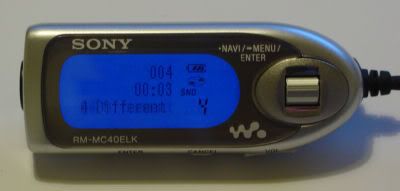
The Sony NW-HD3 hard disk player fits the RM-MC35ELK and the RM-MC40ELK display remotes. Both were designed for Sony's Minidisc players. I'm looking at the RM-MC40ELK because that's what most will go for given the choice.
Ergonomically, the MC40 is rather hodgepodge, packing a scroll wheel, a jog dial and numerous buttons along the sides.
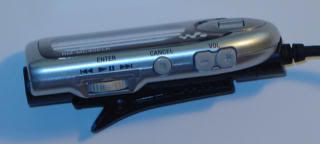
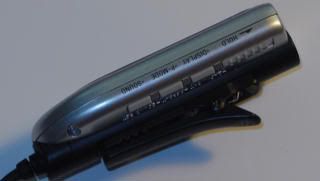
The shirt clip of the remote swings around to accomodate different orientations of bag straps/jackets/etc. A nice touch.
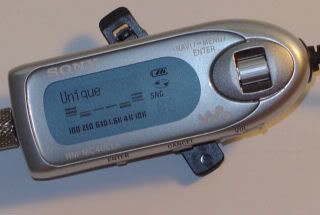
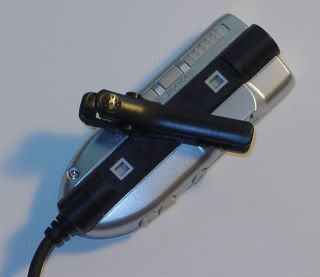
The main reason of being of a display remote is to display track, album, etc information. So it is not ideal to see 'Nostalgi' then wait ages for the title to scroll across the limited display area. The same applies to artists and albums: I do not want to see 'Amy Wineho' then for the scrolling to start a few seconds later. A better example would be that the MC40ELK would display 'Christina ' as the artist name before scrolling. You'd have to hang around for it to scroll to know which Christina you had. Although a small thing in itself, the difference that can make to the speed of navigation is actually quite profound at times. What I'm getting at is pretty simple... the RM-MC40ELK doesn't display enough characters.
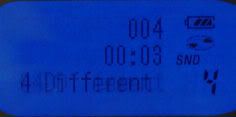
RM-MC40ELK display. The area on the right showing the battery, 'play disc' and 'SND' settings are fixed, not dot mattrix. (ghosting is due to text scrolling movement... I had to use slow shutter speed to enhance the dim backlight)
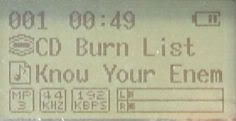
iRiver iMP/iHP remote display
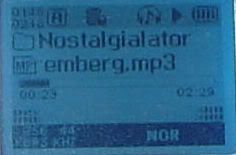
iAudio M3 remote display (sorry about the blurring... it is actually just as crisp, if not more so than the other two in real life)
The backlight of the MC40ELK has been enhanced in these pictures, but in reality it is much dimmer than most other players display remotes. It is however viewable in most light without problems.
All right, so criticisms aside the key question here is does it make using the NW-HD3 any better? Yes I think it does. In addition to the obvious advantages of a remote, the scroll wheel actually makes track and album navigation easier than on the main unit. Putting it another way, it's like the difference between you pressing the 'scroll down' button in a window on your PC to go down a few pages of a document, or using the scroll wheel on your mouse. Better control on the mouse, yes? Better on the RM-MC40ELK too.
It's not the best display remote out there certainly as far as the display area is concerned, and the plethora of controls make for somewhat counterintuitive and 'fumbly' usage, although the payback of the button proliferation is that you have direct access to more functions. It has a useful scroll wheel, the swivelling clip and a good look to it. A good pairing with the NW-HD3, and definitely makes it more usable.
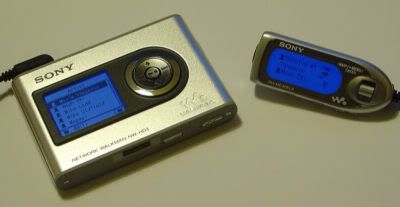
Buy Here
Thursday, January 06, 2005
Listening Test: iPod (3G) vs NW-HD3 vs MZ-NH1 Line Output
I thought I'd hold more formal listening tests than I've done to date, where the HD3 felt pretty similar to the iPod in overall terms of sound. These have been 'lazing on the sofa' and 'trampling along the streets' tests though, so not terribly controlled. Much cable untangling, switching and amp-warming later, I have a more definitive answer. I thought I'd start with the use for these players definitively requiring a high quality output: the use of a Line Out for output to hi-fi and other 'big gear'. This may seem counterintuitive as the purpose of these players are for portable use, but pushing these players to the limit, their differences should be more profound. I chose to do the test on my home headphone "rigs", partially as my replacement speaker amp has not arrived yet and also because I have some of the best headphones around.
I took the NW-HD3 and the top-model MZ-NH1 Hi-MD from the Sony stable, and the older 3rd generation model of the iPod since that's all I have access to at the moment. All of the cables used are the same, new-stock Qunex J2P and were tried with a prototype dynamic amp to drive the Sennheiser and a prototype electrostatic amp to drive the Stax. Normally I wouldn't do test with amps-in-work, but these have already proven themselves very capable. Headphones used were the Sennheiser HD650 with Zu Mobius cable and the Stax SR-007 Omega II. An upgraded and remanufactured instantaneous audio switch was used.
The iPod has a Line Out output on it's dock socket, and it is presented at the back of the dock as a 3.5mm socket. Optional portable docks which allow the Line Out connection to be used are also available in the form of the Sendstation Pocketdock and the Sik Din. The Sony players have a firmware switchable Line Out/Headphone socket and both players were of course placed in Line Out mode prior to the test.
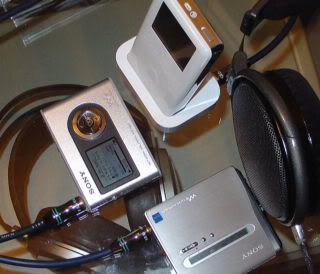
Listening to a range of albums in 256K ATRAC3+ (HD3/NH1) & 256K MP3 (HD3/iPod), all players put up a decent performance and there's not that much to call between them. Still, the MZ-NH1 does come third place behind the HD3 and iPod. The iPod ekes the most detail possible out of the material, and retains the best dynamic range. The iPod retains a very slim lead over the NW-HD3. Users of HD3's don't need feel so bad though: Using most portable amp combinations, the difference is indeed very, very slim and only a really sad geek would lose sleep over the differences.
Now, you'll notice that I said there's not much difference... while using two codecs. Surely ATRAC3+ has been proven to be a superior codec? At lower bitrates, sure. 64K ATRAC3+ is vastly superior to 64K MP3. However at 256K, there's practically nothing in it as far as a codec vs codec comparison is concerned.
Now onto lossless or PCM data. I rip the music to OMG PCM (uncompressed), hit transfer for the HD3 and... er... Sonicstage is converting it to 256K. The realisation comes that it doesn't support uncompressed or lossless music. Honestly, for the normal people among us it's not a huge probem. For rabid portable audiophiles, big problem. The MZ-NH1 does support uncompressed (although not lossless... so you'll effectively need 2Gb of Hi-MD storage for every 1Gb of Apple Lossless). Straight away it's interesting the amount of grain the Hi-MD player generates in comparison to the iPod. This isn't 'fake detail' grain either, it's 'detail missing' grain. The iPod output also retains more dynamic headroom, which makes it cleaner and more impactful. It does seem that Apple really came through for 'higher-end' listeners when they implemented the Apple Lossless codec, as not only is it relatively manageable in size (a typical CD would take up 300MB... big, but still it's not 600MB) on a large-capacity player, it's also genuinely decent quality, possibly the best listening experience out of a portable right now.
With all that said and with the limitations listed, both the iPod and NW-HD3 would actually make good amped players (including for car use), providing your bitrate needs don't go beyond 256K. However, if your uses are 'audiophile', then certainly among the players trialled here the iPod seems to be the only way to travel.
For car use, the iPod can simply be sat in any number of supported car dock solutions incorporating an audio connection and operated normally without doing anything else. The HD3 has no widely available separate jack line-out solutions, so since you've not only got to seat the player on the car stand but also have to plug in the line out cable and switch the player to Line Out mode manually, that may be a hassle factor too far for you. Sony probably missed the trick to put a Line Out signal into the dock connector since there seems to be no news of such accessories.
As an executive summary, the comparison for LINE OUT performance came out as follows:
256K data: iPod > NW-HD3 > MZ-NH1 (differences are small)
Lossless/Uncompressed: iPod > MZ-NH1 (a more noticeable difference) with NW-HD3 sitting out the test.
Headphone out listening tests will come later.
I took the NW-HD3 and the top-model MZ-NH1 Hi-MD from the Sony stable, and the older 3rd generation model of the iPod since that's all I have access to at the moment. All of the cables used are the same, new-stock Qunex J2P and were tried with a prototype dynamic amp to drive the Sennheiser and a prototype electrostatic amp to drive the Stax. Normally I wouldn't do test with amps-in-work, but these have already proven themselves very capable. Headphones used were the Sennheiser HD650 with Zu Mobius cable and the Stax SR-007 Omega II. An upgraded and remanufactured instantaneous audio switch was used.
The iPod has a Line Out output on it's dock socket, and it is presented at the back of the dock as a 3.5mm socket. Optional portable docks which allow the Line Out connection to be used are also available in the form of the Sendstation Pocketdock and the Sik Din. The Sony players have a firmware switchable Line Out/Headphone socket and both players were of course placed in Line Out mode prior to the test.

Listening to a range of albums in 256K ATRAC3+ (HD3/NH1) & 256K MP3 (HD3/iPod), all players put up a decent performance and there's not that much to call between them. Still, the MZ-NH1 does come third place behind the HD3 and iPod. The iPod ekes the most detail possible out of the material, and retains the best dynamic range. The iPod retains a very slim lead over the NW-HD3. Users of HD3's don't need feel so bad though: Using most portable amp combinations, the difference is indeed very, very slim and only a really sad geek would lose sleep over the differences.
Now, you'll notice that I said there's not much difference... while using two codecs. Surely ATRAC3+ has been proven to be a superior codec? At lower bitrates, sure. 64K ATRAC3+ is vastly superior to 64K MP3. However at 256K, there's practically nothing in it as far as a codec vs codec comparison is concerned.
Now onto lossless or PCM data. I rip the music to OMG PCM (uncompressed), hit transfer for the HD3 and... er... Sonicstage is converting it to 256K. The realisation comes that it doesn't support uncompressed or lossless music. Honestly, for the normal people among us it's not a huge probem. For rabid portable audiophiles, big problem. The MZ-NH1 does support uncompressed (although not lossless... so you'll effectively need 2Gb of Hi-MD storage for every 1Gb of Apple Lossless). Straight away it's interesting the amount of grain the Hi-MD player generates in comparison to the iPod. This isn't 'fake detail' grain either, it's 'detail missing' grain. The iPod output also retains more dynamic headroom, which makes it cleaner and more impactful. It does seem that Apple really came through for 'higher-end' listeners when they implemented the Apple Lossless codec, as not only is it relatively manageable in size (a typical CD would take up 300MB... big, but still it's not 600MB) on a large-capacity player, it's also genuinely decent quality, possibly the best listening experience out of a portable right now.
With all that said and with the limitations listed, both the iPod and NW-HD3 would actually make good amped players (including for car use), providing your bitrate needs don't go beyond 256K. However, if your uses are 'audiophile', then certainly among the players trialled here the iPod seems to be the only way to travel.
For car use, the iPod can simply be sat in any number of supported car dock solutions incorporating an audio connection and operated normally without doing anything else. The HD3 has no widely available separate jack line-out solutions, so since you've not only got to seat the player on the car stand but also have to plug in the line out cable and switch the player to Line Out mode manually, that may be a hassle factor too far for you. Sony probably missed the trick to put a Line Out signal into the dock connector since there seems to be no news of such accessories.
As an executive summary, the comparison for LINE OUT performance came out as follows:
256K data: iPod > NW-HD3 > MZ-NH1 (differences are small)
Lossless/Uncompressed: iPod > MZ-NH1 (a more noticeable difference) with NW-HD3 sitting out the test.
Headphone out listening tests will come later.
When green fingers aren't the answer. (OT)
My crassula ovata have started to flower again.

This is much to the chagrin of several people I know who also grow crassula because they can't get it to flower. The interesting thing is that my home is basically a gulag for plants... a short, brutal life cut off by lack of any care. Many have risen to the challenge, but few have survived the test. chlorophytum comosum for example decided to call it a day after only a few weeks at chez bangraman, leaving behind only a few brown husks of it's former self.
On the other hand, crassula seems to relish such neglect, and positively thrives in this environment. So if you're a crap gardener, there's a plant recommendation for you... get crassula. it's not that attractive, but at least it's green. My total plant care regime for these plants extend to highly irregular watering, and cleaning dead leaves and getting the dust off the still living leaves with a vaccum cleaner (obvious tip: don't use full power unless you really like the look of branch stumps).
Crassula however is not the sole surviver of this organic-life-hostile environment. My yucca are the Count Dracula of small trees... They keep rising from the dead.

This is much to the chagrin of several people I know who also grow crassula because they can't get it to flower. The interesting thing is that my home is basically a gulag for plants... a short, brutal life cut off by lack of any care. Many have risen to the challenge, but few have survived the test. chlorophytum comosum for example decided to call it a day after only a few weeks at chez bangraman, leaving behind only a few brown husks of it's former self.
On the other hand, crassula seems to relish such neglect, and positively thrives in this environment. So if you're a crap gardener, there's a plant recommendation for you... get crassula. it's not that attractive, but at least it's green. My total plant care regime for these plants extend to highly irregular watering, and cleaning dead leaves and getting the dust off the still living leaves with a vaccum cleaner (obvious tip: don't use full power unless you really like the look of branch stumps).
Crassula however is not the sole surviver of this organic-life-hostile environment. My yucca are the Count Dracula of small trees... They keep rising from the dead.
Wednesday, January 05, 2005
Sony's "iPod Killer?"
I've had an NW-HD3 in my hands for a bit now. This is Sony's first hard-disk player which can honestly stand up and say that it's actually competition for the rest of the players out there on the market.
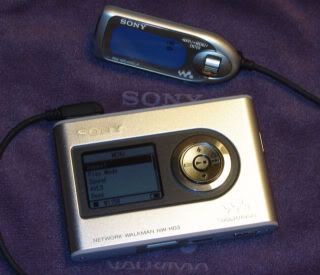
You'll have to wait for a review, but my current opinion is split down the middle. Great hardware... potentially the best right now, sound's not bad at all either but it also has piss-poor software in comparison with the competition, allied to very indifferent firmware which incorporates usability that could only be considered roughly equivalent to a low-end MP3 Discman.
I think it's pretty clear from my tone above that it's not the definitive iPod Killer, but plenty of people will be interested in this player because of the hardware and because it's not an iPod. So the aim of the review will be to highlight what you're giving up in order to have something that's sexily styled, pretty small, can be allied to a display remote and lasts 20+ hours on a charge... and whether it's worth it.

You'll have to wait for a review, but my current opinion is split down the middle. Great hardware... potentially the best right now, sound's not bad at all either but it also has piss-poor software in comparison with the competition, allied to very indifferent firmware which incorporates usability that could only be considered roughly equivalent to a low-end MP3 Discman.
I think it's pretty clear from my tone above that it's not the definitive iPod Killer, but plenty of people will be interested in this player because of the hardware and because it's not an iPod. So the aim of the review will be to highlight what you're giving up in order to have something that's sexily styled, pretty small, can be allied to a display remote and lasts 20+ hours on a charge... and whether it's worth it.
A.N.T. Amber headphone amplifier
Link to my Head-Fi preview post
What Alex is trying to do is quite intriguing, and you can read more about it on his site, www.ant-audio.co.uk. This amp is excellent for the money, although the strength of the pound makes it a bit of a mouthful for US buyers at the moment.
Despite the paucity of the visuals, an objective assessment reveals that technically speaking, it does whip some $600~$800 amps and it does have a rather nice tone as well, backed up by expansive soundstaging.
I haven't tried all of the competing amps. But giving a couple of examples, it certainly kicks dust in the Larocco Deluxe PPA's face and shows the Ray Samuels XP-7 a thing or two as well. Both of these (in fact all of the others I bought and tried) are better presented items, but if accuracy as well as a great sound is your overriding requirement, then the Amber will do a superb job.
The biggest problem of the ANT is sadly the visuals. Since audiophilia incorporates the aesthetic and geeky, if the gear doesn't look right then for many people it doesn't sound right. Unless you can be very objective then your opinions as a potential owner or even just a reviewer are highly likely to be swayed by the way something looks. It's easily the single biggest stumbling block towards wider acceptance of the ANT amps... but if you can get past it, it's a belter.
What Alex is trying to do is quite intriguing, and you can read more about it on his site, www.ant-audio.co.uk. This amp is excellent for the money, although the strength of the pound makes it a bit of a mouthful for US buyers at the moment.
Despite the paucity of the visuals, an objective assessment reveals that technically speaking, it does whip some $600~$800 amps and it does have a rather nice tone as well, backed up by expansive soundstaging.
I haven't tried all of the competing amps. But giving a couple of examples, it certainly kicks dust in the Larocco Deluxe PPA's face and shows the Ray Samuels XP-7 a thing or two as well. Both of these (in fact all of the others I bought and tried) are better presented items, but if accuracy as well as a great sound is your overriding requirement, then the Amber will do a superb job.
The biggest problem of the ANT is sadly the visuals. Since audiophilia incorporates the aesthetic and geeky, if the gear doesn't look right then for many people it doesn't sound right. Unless you can be very objective then your opinions as a potential owner or even just a reviewer are highly likely to be swayed by the way something looks. It's easily the single biggest stumbling block towards wider acceptance of the ANT amps... but if you can get past it, it's a belter.
Audio-Technica ATH-ES5 portable headphones
New portable headphones from Audio-Technica, available outside of Japan from Audiocubes, Bluetin and so forth. Product Link (Japanese)
The ATH-ES5 is a folding portable headphone designed for use with Walkmen, etc. It is claimed to be closed back, and is efficient enough to be used from almost any MP3/CD/MD player. It's primary competitor in Europe and in the US is Sennheiser's PX200, and considering import costs and so forth, the ES5 would end up around double the price of the PX200 to most. Even in Japan, the ES5 is more expensive than the PX200. However both are aimed at the same type of usage, so I compared the ES5 against the PX200 in many respects.
DESIGN/CONSTRUCTION
A very good looking headphone, the ATH-ES5 is worthy of it's 'Earsuit' name. The styling is different, with a cantilevered earcup mount and the lines are crisp yet understated. Technical touches abound emphasising attention to detail. Examples include the solidly constructed folding hinges, and the seemingly all-plastic headband which is actually topped with an anti-skid rubber covering to prevent the phones from moving around the head. The 'swoop' of the earcup mount flows towards the front (not towards the back) and it does definitely make a discreet style statement. In addition to the pictured black/silver, an all-black model is available.

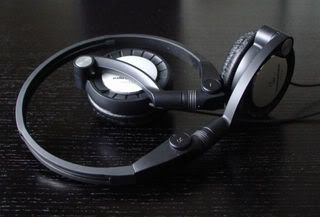
The phone folds/unfolds by rotating the earcup to a raised state, rotating the cantilevered mount by 90 degrees then folding at the joint. You can see how that happens by the half folded phone shown above.

The fully folded ES5 is definitely jacket pocketable, although it will end up taking up practically all of the jacket pocket. The folded PX200 also shown takes up less space, due to a better designed folding system.
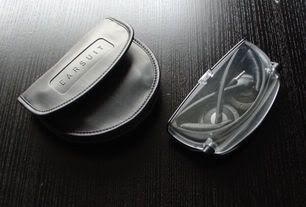
Both ATH-ES5 and PX200 ship with cases. The ES5 ships with a very nice soft case, while the PX200 ships with a cheaper looking but more protective hard case.
The overall feeling of quality has to go to the ATH-ES5. It generally feels very well put together and has material touches of definite quality. However, all is not well. There is no external strain relief in the headphone cables at the earcup end which will inevitably lead to premature cable failure, and the folding process is extremely cumbersome, especially when compared with the Sennheiser's well-engineered, quick and ingenious folding method.
Comfort is decent, although the earcups do tend to 'bow' outwards at the back of the ear due to the phone's design... and that leads to another problem: While the cantilevered earcup mount looks different, the disadvantage of it compared to a centre-of-earcup mounting like the PX200 is an offset application of pressure on the ears towards the front of the ear, which works against the truly effective placement of the earcups.
ISOLATION
The ATH-ES5 is billed as a closed phone. However, there is a noticeable amount of sound leakage to the outside for a closed phone from these phones and they do not isolate external sounds a great deal. I have tracked this down to tiny vents on the back of the earcups. The genuinely closed Sennheiser PX200 manages very little leakage at arm's length and do isolate a usable amount... no more than 10db I estimate, but still surprisingly effective in most locations.
SOUND
Slightly better news for the ATH-ES5 here. First of all, the ES5 is noticeably efficient, which means that the power from headphone jacks is optimised so you'll get more decibels at a given volume. The PX200 has a noticeably lower efficiency.
The PX200 has a slightly 'slow' response, i.e. the sound is slightly dull and sluggish. The (bloated) bass is there in spades, but there's not a dynamic sense of agility that I'm used to hearing in good phones. Even at this price point, there are better sounding headphones than the PX200, although none in the mainstream which actually offers isolation and non-leakage. The ATH-ES5 features a slightly more sparkling sound than the PX200 which offers more detail in the sound, but the mids exhibit some nasal effects and the lows are similar to the PX200... slightly slow and bloated.
Pulling back a bit and offering a layman's perspective, both of these phones will sound pretty good if you haven't tried any high-end phones, but won't win any awards for sound. The PX200 can be somewhat excused for any faults here as it offers isolation, and that nearly always comes at a sonic penalty. The ES5 doesn't offer much in the way of isolation, so it should sound better... and it does, but not by much.
OVERALL VERDICT
A high quality product incorporating excellent aesthetics in the usual Audio-Technica way, but beset by certain fundamental engineering problems which undoubtedly cropped up in the quest to look different. Relatively poor folding design, lack of isolation, high cost for non-Japanese residents ($100-ish) combined with only slightly above PX200-level sound quality means that you should really only consider these if your sole aim is to look different - and yet the understated nature of these phones mean that they don't actually grab the casual eye anyway. They offer no real peformance advantages over the PX200. In fact, one might say that in many ways they are a step back. In my opinion, worth a look only for Japanese residents, and only at a sale ;-)
LONG-TERM USE ADDENDUM
The core of the above review was worked on some time ago, and it's now time to add some long-term listening notes on these.
PHYSICAL/COMFORT
The build quality of these phones is really first class. After relatively long-term use (although in my case not everyday use) the phones are still holding up nicely and nothing has come loose or broken. That is with careful use though. The cables which lack strain relief have not give up yet. However the non-slip elastomer covering of the cables has proven to be an immense annoyance, tangling with remote cables and so forth at every opportunity.
As for long-term use actually on the head, if you read the above review I refer to the potential discomfort of the cantilevered earcup mount creating spot pressure instead of an even pressure on the ears. Here's how to simulate it:

Put your index finger roughly where the red circle is in relation to your head. Now press down quite hard. Do that for a while. That's what wearing the ATH-ES5 feels like. Relatively speaking, I find the Sony G74SL, of which I complained about the comfort, actually more comfortable.
SOUND
Has the sound settled down a bit? Well, the low-end extension has increased a little. Provided your portable can do it, the ES5 is capable of knocking out some very decent lows, combined with good extension at the trebles too. It certainly 'out-sparkles' the $30 Sony MDR-G74SL and the $50 PX200, and you do hear more information... but that's provided you can hear the phones as the lack of any isolation still applies, which is annoying since these are supposed to be closed.
LONG-TERM VERDICT
Still distinctly unimpressed given what non-Japanese residents will be paying. I think my initial overall verdict still applies... It is better than the PX200/MDR-G4SL/etc, but there are better $100-$110 phones, some of which are actually closed. In my opinion, still only worth considering if you're a Japanese resident.
The ATH-ES5 is a folding portable headphone designed for use with Walkmen, etc. It is claimed to be closed back, and is efficient enough to be used from almost any MP3/CD/MD player. It's primary competitor in Europe and in the US is Sennheiser's PX200, and considering import costs and so forth, the ES5 would end up around double the price of the PX200 to most. Even in Japan, the ES5 is more expensive than the PX200. However both are aimed at the same type of usage, so I compared the ES5 against the PX200 in many respects.
DESIGN/CONSTRUCTION
A very good looking headphone, the ATH-ES5 is worthy of it's 'Earsuit' name. The styling is different, with a cantilevered earcup mount and the lines are crisp yet understated. Technical touches abound emphasising attention to detail. Examples include the solidly constructed folding hinges, and the seemingly all-plastic headband which is actually topped with an anti-skid rubber covering to prevent the phones from moving around the head. The 'swoop' of the earcup mount flows towards the front (not towards the back) and it does definitely make a discreet style statement. In addition to the pictured black/silver, an all-black model is available.


The phone folds/unfolds by rotating the earcup to a raised state, rotating the cantilevered mount by 90 degrees then folding at the joint. You can see how that happens by the half folded phone shown above.

The fully folded ES5 is definitely jacket pocketable, although it will end up taking up practically all of the jacket pocket. The folded PX200 also shown takes up less space, due to a better designed folding system.

Both ATH-ES5 and PX200 ship with cases. The ES5 ships with a very nice soft case, while the PX200 ships with a cheaper looking but more protective hard case.
The overall feeling of quality has to go to the ATH-ES5. It generally feels very well put together and has material touches of definite quality. However, all is not well. There is no external strain relief in the headphone cables at the earcup end which will inevitably lead to premature cable failure, and the folding process is extremely cumbersome, especially when compared with the Sennheiser's well-engineered, quick and ingenious folding method.
Comfort is decent, although the earcups do tend to 'bow' outwards at the back of the ear due to the phone's design... and that leads to another problem: While the cantilevered earcup mount looks different, the disadvantage of it compared to a centre-of-earcup mounting like the PX200 is an offset application of pressure on the ears towards the front of the ear, which works against the truly effective placement of the earcups.
ISOLATION
The ATH-ES5 is billed as a closed phone. However, there is a noticeable amount of sound leakage to the outside for a closed phone from these phones and they do not isolate external sounds a great deal. I have tracked this down to tiny vents on the back of the earcups. The genuinely closed Sennheiser PX200 manages very little leakage at arm's length and do isolate a usable amount... no more than 10db I estimate, but still surprisingly effective in most locations.
SOUND
Slightly better news for the ATH-ES5 here. First of all, the ES5 is noticeably efficient, which means that the power from headphone jacks is optimised so you'll get more decibels at a given volume. The PX200 has a noticeably lower efficiency.
The PX200 has a slightly 'slow' response, i.e. the sound is slightly dull and sluggish. The (bloated) bass is there in spades, but there's not a dynamic sense of agility that I'm used to hearing in good phones. Even at this price point, there are better sounding headphones than the PX200, although none in the mainstream which actually offers isolation and non-leakage. The ATH-ES5 features a slightly more sparkling sound than the PX200 which offers more detail in the sound, but the mids exhibit some nasal effects and the lows are similar to the PX200... slightly slow and bloated.
Pulling back a bit and offering a layman's perspective, both of these phones will sound pretty good if you haven't tried any high-end phones, but won't win any awards for sound. The PX200 can be somewhat excused for any faults here as it offers isolation, and that nearly always comes at a sonic penalty. The ES5 doesn't offer much in the way of isolation, so it should sound better... and it does, but not by much.
OVERALL VERDICT
A high quality product incorporating excellent aesthetics in the usual Audio-Technica way, but beset by certain fundamental engineering problems which undoubtedly cropped up in the quest to look different. Relatively poor folding design, lack of isolation, high cost for non-Japanese residents ($100-ish) combined with only slightly above PX200-level sound quality means that you should really only consider these if your sole aim is to look different - and yet the understated nature of these phones mean that they don't actually grab the casual eye anyway. They offer no real peformance advantages over the PX200. In fact, one might say that in many ways they are a step back. In my opinion, worth a look only for Japanese residents, and only at a sale ;-)
LONG-TERM USE ADDENDUM
The core of the above review was worked on some time ago, and it's now time to add some long-term listening notes on these.
PHYSICAL/COMFORT
The build quality of these phones is really first class. After relatively long-term use (although in my case not everyday use) the phones are still holding up nicely and nothing has come loose or broken. That is with careful use though. The cables which lack strain relief have not give up yet. However the non-slip elastomer covering of the cables has proven to be an immense annoyance, tangling with remote cables and so forth at every opportunity.
As for long-term use actually on the head, if you read the above review I refer to the potential discomfort of the cantilevered earcup mount creating spot pressure instead of an even pressure on the ears. Here's how to simulate it:

Put your index finger roughly where the red circle is in relation to your head. Now press down quite hard. Do that for a while. That's what wearing the ATH-ES5 feels like. Relatively speaking, I find the Sony G74SL, of which I complained about the comfort, actually more comfortable.
SOUND
Has the sound settled down a bit? Well, the low-end extension has increased a little. Provided your portable can do it, the ES5 is capable of knocking out some very decent lows, combined with good extension at the trebles too. It certainly 'out-sparkles' the $30 Sony MDR-G74SL and the $50 PX200, and you do hear more information... but that's provided you can hear the phones as the lack of any isolation still applies, which is annoying since these are supposed to be closed.
LONG-TERM VERDICT
Still distinctly unimpressed given what non-Japanese residents will be paying. I think my initial overall verdict still applies... It is better than the PX200/MDR-G4SL/etc, but there are better $100-$110 phones, some of which are actually closed. In my opinion, still only worth considering if you're a Japanese resident.
Extended isolation for Shure E5c
Feeling cheated that the E5's don't provide quite the level of isolation that the Etymotic ER-4P/S does? Buy a bag of the Etymotic ER-6i/Etycom tips and seat them fully onto the E5c. Works a treat... although it will make them nearly as uncomfortable as the Etymotics in the process. Works on the Shure E3c as well.
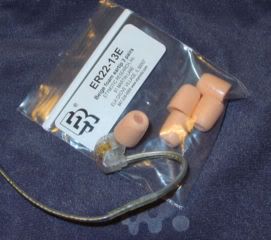

Monday, January 03, 2005
Sony MDR-G74SL Walkman headphones
(Reposted from May 2004)
Finally, I had to do it... Rip the packaging off a Sony MDR-G74SL headphone that's been collecting mould in my 'things to listen to' cabinet.
The 'Street Styles' are universally panned by those with and without experience of them on Head-Fi as phones that sound like ass and leak like crazy too. I wasn't too keen to stick the G74 on my head, but having taken them out of the packaging I have to say that Sony have made an effort with the design and materials. It really is very stylish, and looks extremely cool even on my head. In terms of how the design looks, these are a considerable improvement on the Koss KSC-35 and the Sennheiser PX100 / PX200 with a clean flow to the look (IMO, although the PX series gets very close).
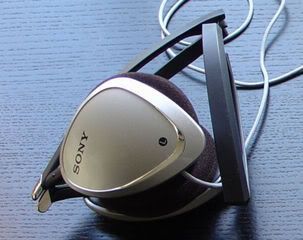
The phone is well constructed, it folds into a reasonably compact package (although not as flat as the Sennheisers). The remote-friendly, short main cable is of a cloth material and is terminated in a super-low mass, super small 3.5mm plug. The phone includes an extension cable with the same cloth covering and low-mass connectors.
Outward sound leakage is not bad. The phone is open but has a back shield of sorts, and things don't just go straight out of the phones into the ear of the person next to you. On a fairly quiet train I couldn't hear above a very slight level of leakage even at slightly above normal listening levels from 30cm away. The inward leakage is pretty much like any reasonably open design phone. You can hear everything going on around you but it's not as apparent as some 'sonic sieves' like Grado phones.
Highs are fairly clean, pretty well represented and not rough. It's all there with a reasonable degree of precision. Low-end extension (extension = the ability to play notes at the extremes of a given range) is good, and it's pretty entertainingly tight. Bass hits come and go without any significant degree of bloat, and with a satisfying attack and weight. (bloat = when a note hangs around for longer than it should) The Sennheiser PX200 (when fitted properly) has a heavy bass hit plus a fair bit of bloat. In comparison to the PX200, the G74 has cleaner and just as weighty bass notes while providing more starting attack.
We've had the good. Now onto the bads. Comfort is as bad as and maybe worse than previous Street Styles for me. Pinched the tops of my ears after a short time and I had to constantly adjust them to stop them hurting. Midrange sounds are honky. What do I mean by 'honky'? There's an enclosed, phased effect to the midrange (especially apparent in vocal choruses) which gives it an over-prominence. It's not something you'd necessarily notice in a portable scenario with lots of background noise, but in a quiet spot to these ears it's disconcerting.
So there it is. It's not as leaky as the Koss KSC-35/PX100 but not as sealed as a PX200, it sounds cleaner than a PX200 but honkier than both the PX100/200, is less comfortable than them and slightly bulkier when folded. It has nice lows, not too bad highs, slightly objectionable mids. And it looks better than any of the PX's. Would I buy it over the PX phones? Probably not, even if only for the reason that the G74 doesn't pack flat. But it does look pretty cool...
CNet Review
Finally, I had to do it... Rip the packaging off a Sony MDR-G74SL headphone that's been collecting mould in my 'things to listen to' cabinet.
The 'Street Styles' are universally panned by those with and without experience of them on Head-Fi as phones that sound like ass and leak like crazy too. I wasn't too keen to stick the G74 on my head, but having taken them out of the packaging I have to say that Sony have made an effort with the design and materials. It really is very stylish, and looks extremely cool even on my head. In terms of how the design looks, these are a considerable improvement on the Koss KSC-35 and the Sennheiser PX100 / PX200 with a clean flow to the look (IMO, although the PX series gets very close).

The phone is well constructed, it folds into a reasonably compact package (although not as flat as the Sennheisers). The remote-friendly, short main cable is of a cloth material and is terminated in a super-low mass, super small 3.5mm plug. The phone includes an extension cable with the same cloth covering and low-mass connectors.
Outward sound leakage is not bad. The phone is open but has a back shield of sorts, and things don't just go straight out of the phones into the ear of the person next to you. On a fairly quiet train I couldn't hear above a very slight level of leakage even at slightly above normal listening levels from 30cm away. The inward leakage is pretty much like any reasonably open design phone. You can hear everything going on around you but it's not as apparent as some 'sonic sieves' like Grado phones.
Highs are fairly clean, pretty well represented and not rough. It's all there with a reasonable degree of precision. Low-end extension (extension = the ability to play notes at the extremes of a given range) is good, and it's pretty entertainingly tight. Bass hits come and go without any significant degree of bloat, and with a satisfying attack and weight. (bloat = when a note hangs around for longer than it should) The Sennheiser PX200 (when fitted properly) has a heavy bass hit plus a fair bit of bloat. In comparison to the PX200, the G74 has cleaner and just as weighty bass notes while providing more starting attack.
We've had the good. Now onto the bads. Comfort is as bad as and maybe worse than previous Street Styles for me. Pinched the tops of my ears after a short time and I had to constantly adjust them to stop them hurting. Midrange sounds are honky. What do I mean by 'honky'? There's an enclosed, phased effect to the midrange (especially apparent in vocal choruses) which gives it an over-prominence. It's not something you'd necessarily notice in a portable scenario with lots of background noise, but in a quiet spot to these ears it's disconcerting.
So there it is. It's not as leaky as the Koss KSC-35/PX100 but not as sealed as a PX200, it sounds cleaner than a PX200 but honkier than both the PX100/200, is less comfortable than them and slightly bulkier when folded. It has nice lows, not too bad highs, slightly objectionable mids. And it looks better than any of the PX's. Would I buy it over the PX phones? Probably not, even if only for the reason that the G74 doesn't pack flat. But it does look pretty cool...
CNet Review
Beyerdynamic DT231 headphones
These phones are what I could call 'why spend more?' phones. OK, so they don't isolate surrounding noise. Maybe they aren't supremely comfortable. In fact, they're pretty uncomfortable if you try and wear them as circumaural phones, which is the best way to get the most impact out of these. But hearing them out of the headphone socket of my SACD player without a dedicated headphone amp, well a bit of the 'why spend more?' questions come out.
The DT231 are 1/30th of the cost of the cable that links my SACD player to the amp for the Stax Omega II headphones, itself retailing for 100 timesthe cost of the Beyerdynamic phone. Is the other headphone set-up 130 times better than the DT231? Hell no. Is it even 30 times better? Absolutely not. I'm at a loss to pin down exactly how many times better the Omega II set-up is, but it's well below 30. (of course, your 'times table' will differ according to your own requirements. I take a fairly sceptical approach to the whole thing)
The truth is that you're not missing out on a significant amount of the musicality of the performance on the DT231 with a decent cheap headphone amp (or a decent receiver headphone jack) when compared to some of the best headphone gear that money can buy. Yes of course, it doesn't resolve anywhere near as well and when pushed it is a little rough... but this is a $60 headphone.

One thing I have to mention though, which is that they look terrible. Like artifacts from the 80's combined with the 'lets make everything iMac transparent' earcups from the late 90's on the 'upgraded' DT231 Galactic, and on the standard DT231 the plastic they use to mould both headband and earcups seems to be of the same colour as those fake dog poos.
I'm not going to write reams of text about how this phone does things: All I will say is that this phone has the essential sonic flavour of the best high-end phones, coupled with a fair percentage of their technical performance as well. All this, while throwing in a little more bass than many high-enders to give you a more rounded sound.
Personally speaking, just for PC listening or things like that, I could be extremely happy with the DT231 if only they were a bit more comfy. That's about the only criticism as home listening phones I can level against them. The DT231 gives you more than a peek at how high-end phones sound, and it's very impressive for that.
Manufacturer Link
The DT231 are 1/30th of the cost of the cable that links my SACD player to the amp for the Stax Omega II headphones, itself retailing for 100 timesthe cost of the Beyerdynamic phone. Is the other headphone set-up 130 times better than the DT231? Hell no. Is it even 30 times better? Absolutely not. I'm at a loss to pin down exactly how many times better the Omega II set-up is, but it's well below 30. (of course, your 'times table' will differ according to your own requirements. I take a fairly sceptical approach to the whole thing)
The truth is that you're not missing out on a significant amount of the musicality of the performance on the DT231 with a decent cheap headphone amp (or a decent receiver headphone jack) when compared to some of the best headphone gear that money can buy. Yes of course, it doesn't resolve anywhere near as well and when pushed it is a little rough... but this is a $60 headphone.

One thing I have to mention though, which is that they look terrible. Like artifacts from the 80's combined with the 'lets make everything iMac transparent' earcups from the late 90's on the 'upgraded' DT231 Galactic, and on the standard DT231 the plastic they use to mould both headband and earcups seems to be of the same colour as those fake dog poos.
I'm not going to write reams of text about how this phone does things: All I will say is that this phone has the essential sonic flavour of the best high-end phones, coupled with a fair percentage of their technical performance as well. All this, while throwing in a little more bass than many high-enders to give you a more rounded sound.
Personally speaking, just for PC listening or things like that, I could be extremely happy with the DT231 if only they were a bit more comfy. That's about the only criticism as home listening phones I can level against them. The DT231 gives you more than a peek at how high-end phones sound, and it's very impressive for that.
Manufacturer Link
Subscribe to:
Posts (Atom)
